

Hua Hin Artist Village Visiting Guide- Is it worth a visit?
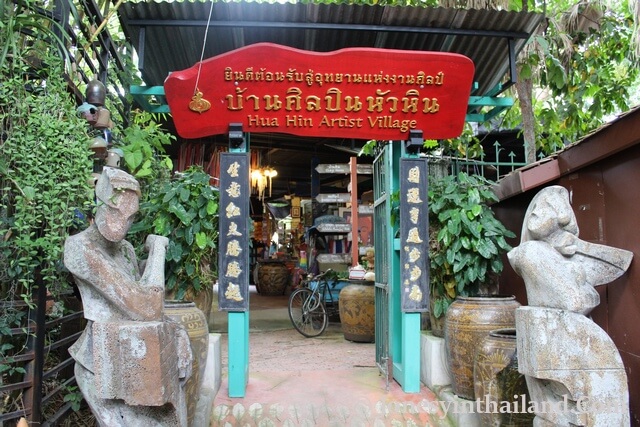
Baan Sillapin Artists Village in Hua Hin is a fabulous little retreat place to visit that’s just outside of the town selling and displaying a great art selection and collections.
Just 5km from the main centre (clock tower) of Hua Hin is the Artist Village which is most definitely worth a visit – even if you don’t plan to buy any art.
A visit to the Artists Village is among the top choices of things to do in Hua Hin and Attractions .
The look and feel of the place and the restaurant next to the lily pond alone may make it well worth a visit, as it did for me.
Open: Daily (closed Mondays) – 10.00 am – 5.00 pm Admission: 20 THB kids, 40 THB adults Address: 299/8 3218 Tambon Hin Lek Fai, Amphoe Hua Hin, Chang Wat Prachuap Khiri Khan 77110.
Artist Village Things To Know
The village or arts centre was opened up in the year 2000, and the website states that 15 artists work there as well as other support staff.
When walking through you get a village feel of the place, and most of the small buildings and artists’ rooms are wooden which provides a traditional Thai feel.
There is a charge of 40 THB at the entrance for adults and 20 THB for children.
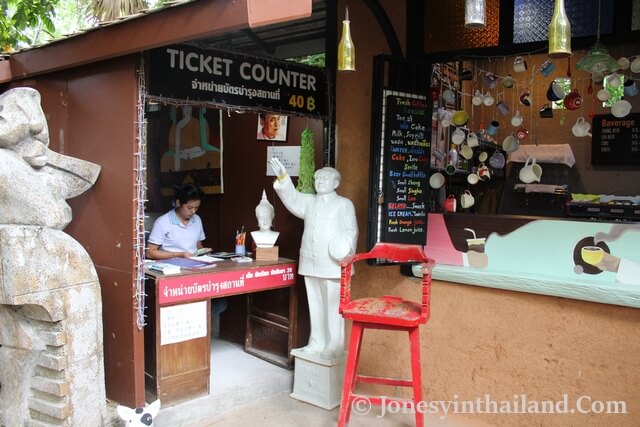
To walk around the arts village and out the other side it may only take about 10 minutes, and then it will depend on how much time you want to look at the artwork. Despite visiting during the very hot season walking around inside was not too hot.
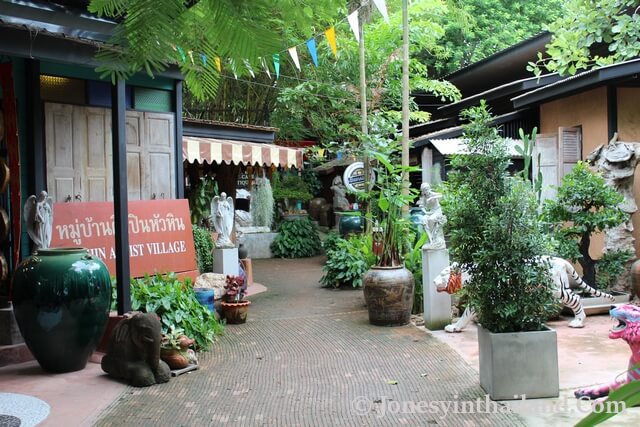
You can purchase many of the art items, and some are reasonably priced that could make suitable souvenirs for people back home.
Visitors are able to attend DIY workshops for painting and clay work; however, there is nobody to teach you – it’s a do-it-yourself area, and staff will support people. It is great for children and costs 100 THB for kids and 150 THB for adults. There is a charge for other materials, such as clay.
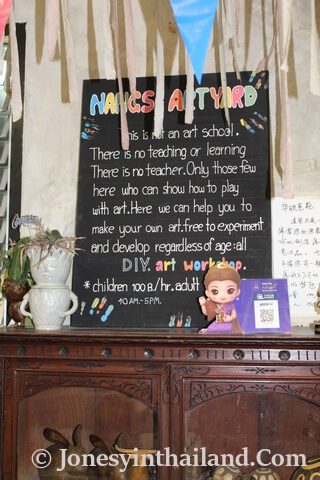
There is a cool cafe to stop off at for refreshments with a view of the small but beautiful lake. Art and crafts are displayed in the cafe for sale.
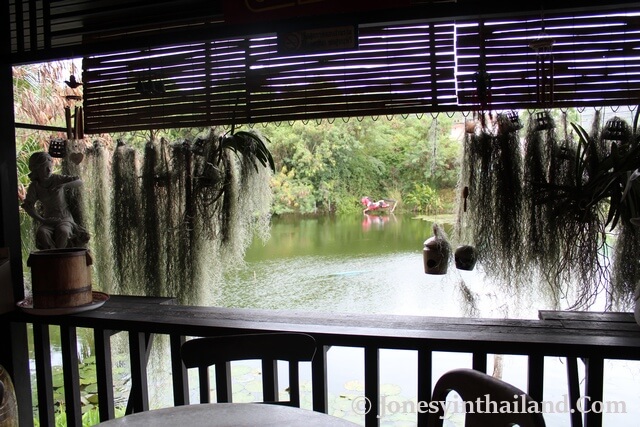
Baansillapin Restaurant
This is a great restaurant with a really good menu of Thai food. I only got to try out the noodles with a pouched egg in the centre, and they were really delicious.
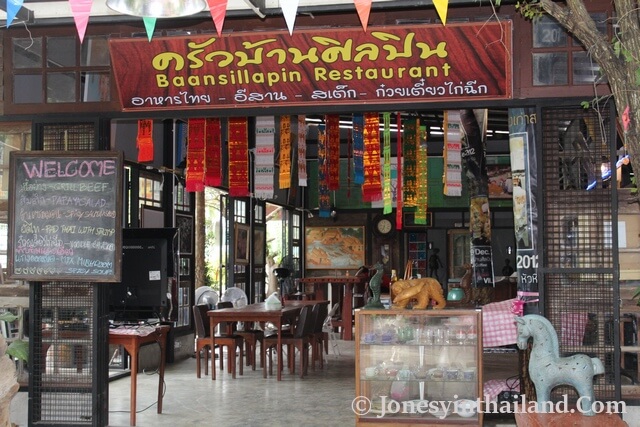
I can imagine (I have enough experience of Thai food) just by trying the noodles that other dishes here are pretty good, which makes just coming along to eat here near the lily pond worth the 5km trip out of Hua Hin centre if you have transport.
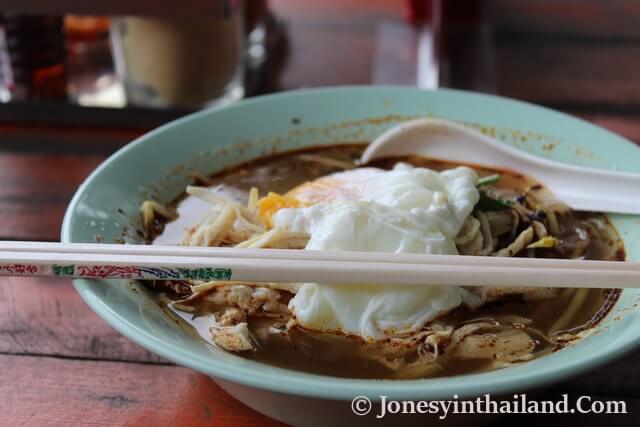
Getting To The Artists’ Village
It’s easy to get to if you are on a motorbike or driving a car, and just 5km from the centre of Hua Hin. Taxis or tuk-tuks (small open vans) will cost around 200 + THB each way.
I asked one driver while I was at the arts village how much he charges, and he quoted 600 THB for bringing passengers from central Hua Hin, waiting and returning.
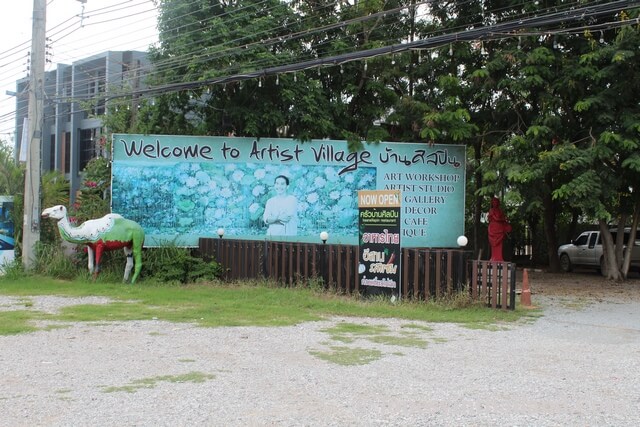
I’m Jonesy. The one responsible for whole lot of things including having this Thailand site up and running. I first arrived in Thailand in 2008 and being a web developer it made sense to create a website and write some stuff about my second home. Enjoy your travels!
Related - Hua Hin
- Getting Around Hua Hin - Available Transport Options
- Hua Hin Travel Guides
- Bangkok to Hua Hin Transport Options
- Hua Hin Beach Guide – Everything to Know
- Bangkok to Hua Hin Train Times, Costs, Booking & Journey Info
- Hua Hin To Bangkok Train Times, Costs, Booking & Journey Info
- Hua Hin Railway Station Guide – Feel & See The 1920’s
- Minivans from Hua Hin to Bangkok – Times, Booking and Picking Up Points
- Hua Hin Attractions & Things To Do
- Baan Sillapin Artists Village in Hua Hin
- Rajabhakti Park – 7 Kings Statues - Worth Visiting?
- Khao Hin Lek Fai Guide–Is it Worth Visiting?
- Chopstick Hill & Wat Khao Takiab –Everything to Know!
- Wat Huay Mongkol Temple in Hua Hin Guide–Is It Worth Visiting?
- Top 8 Hua Hin Night Markets Worth Checking Out
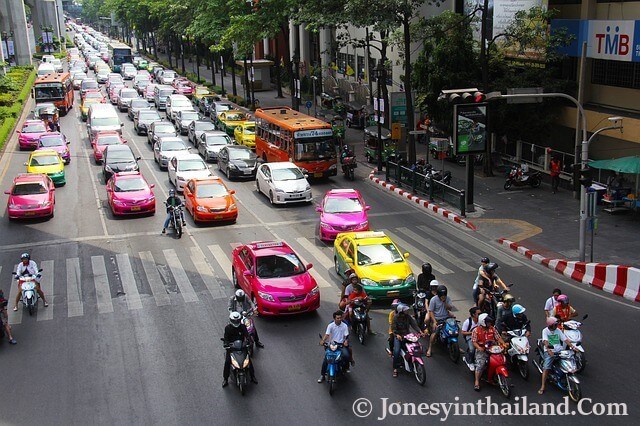
Bangkok Travel
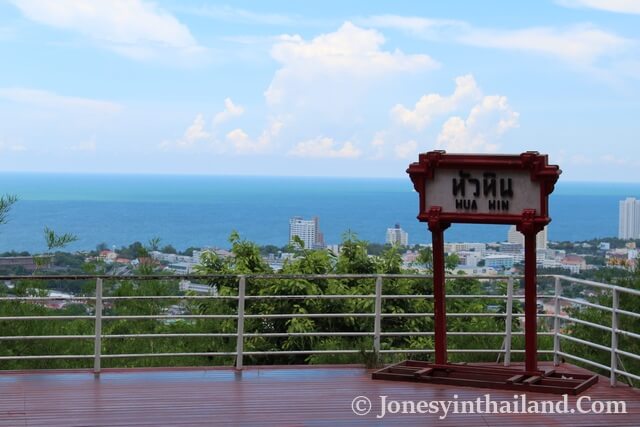
Hua Hin Travel
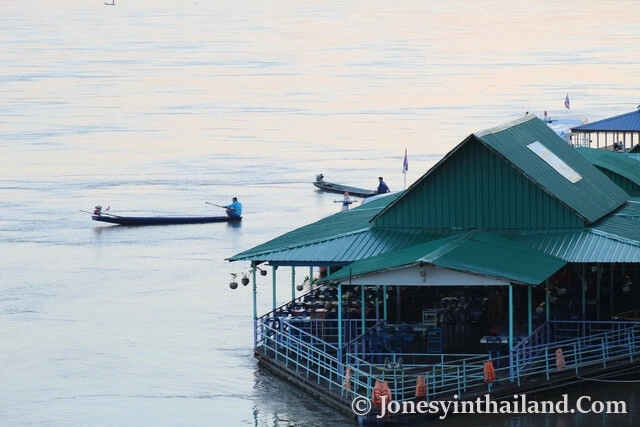
Nong Khai Travel
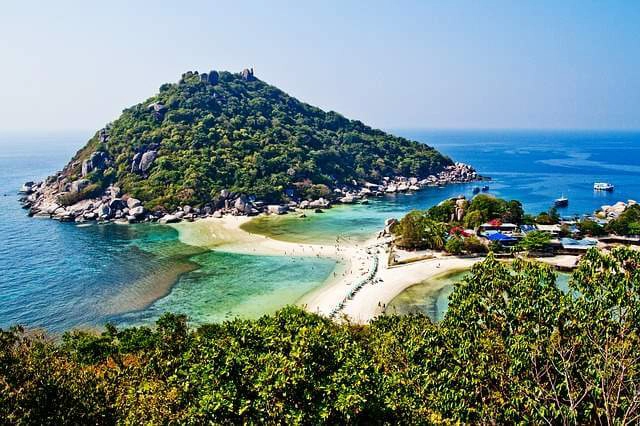
Where To Go In Thailand? - Top Places To Visit
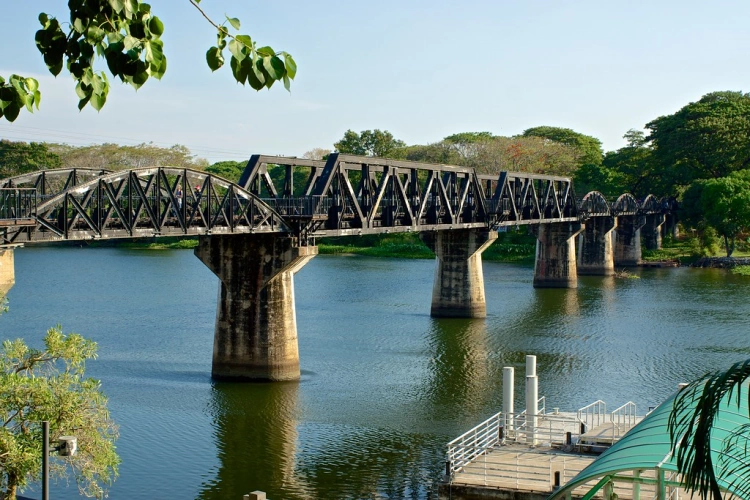
Kanchanaburi Travel
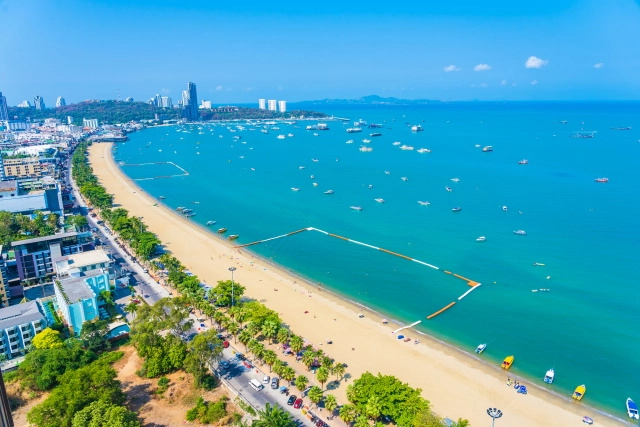
Pattaya Travel
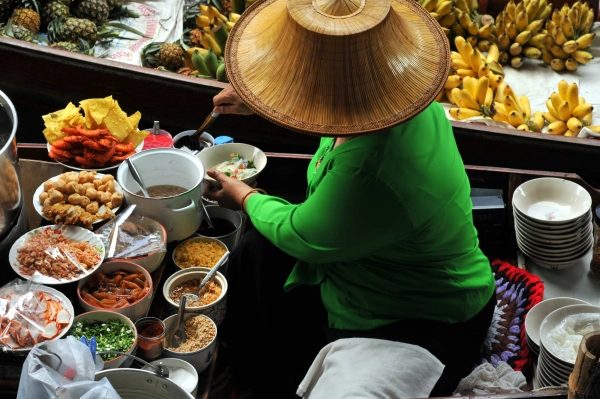
Food of Thailand
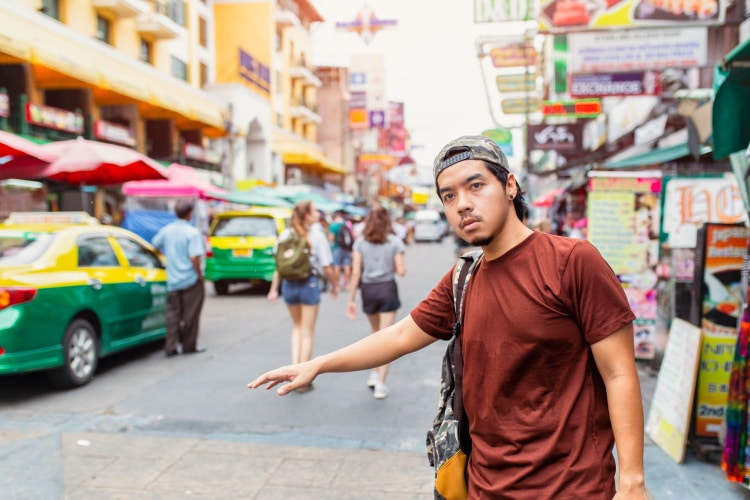
Transport in Thailand
- Artist Studio’s
- Art Gallery – Exhibition Hall
- Art workshops
- Antique shop
- Art Materials & Framing
- Where are we?
About Hua Hin Artist Vilage
Our team members, more facts about us, our latest projects, some random pictures, find out more about us.
Many websites, magazines and television programs have been made about the Artist Village, please check youtube or:
Share a Little Love
Come for a visit.

- Travel Blog
- Privacy Policy
- Vietnam at a Glance - 12 Days
- Highlights of Vietnam - 15 Days
- Vietnam Deluxe Journey - 16 Days
- Classic Tours
- Halong Tours
- Ninhbinh Tours
- Dongtaybac Tours
- Hanoi Tours
- Hagiang Tours
- Maichau Tours
- Hue - Danang & Hoian Tours
- Nhatrang Tours
- Dalat Tours
- Quangbinh Tours
- Ninhthuan Tours
- Saigon Tours
- Mekong Delta Tours
- Phuquoc Tours
- Condao Tours
- Muine Tours
- Phu Quoc Beach
- Con Dao Island
- Nha Trang Beach Holiday
- Da Nang Beach
- Vung Tau Beach break
- Quy Nhon Beach vacation
- Cambodia Tours
- Thailand Tours
- Myanamar Tours
- Vietnam - Cambodia Tours
- China Tours
- Japan Tours
- Korea Tours
- Taiwan Tours
- Singapore Tours
- Tibet Tours
- Halong Cruises
- Mekong Cruises
- Hotels in Hanoi
- Hotels in Halong
- Hotels in Sapa
- Hotels in Ninh Binh
- Hotels in Danang
- Hotels in Hue
- Hotels in Saigon
- Hotels in Vung Tau
- Hotels in Phan Thiet
- Hotels in Nha Trang
- Hotels in Phu Quoc
- Hotels in Quy Nhon
- Hotels in Can Tho
- Hotels in Chau Doc
- Visa Application Process
- Visa Information
Visiting Hua Hin Artist Village – A lovely little enclave of Thai artists.

Have you checked in many times in Thailand with known locations such as Chiang Mai, Phuket, or the capital of Bangkok, and are searching for a fresh experience, Baan Sillapin Artists Village (or Baan Silapin Artists Village) is a must-see.
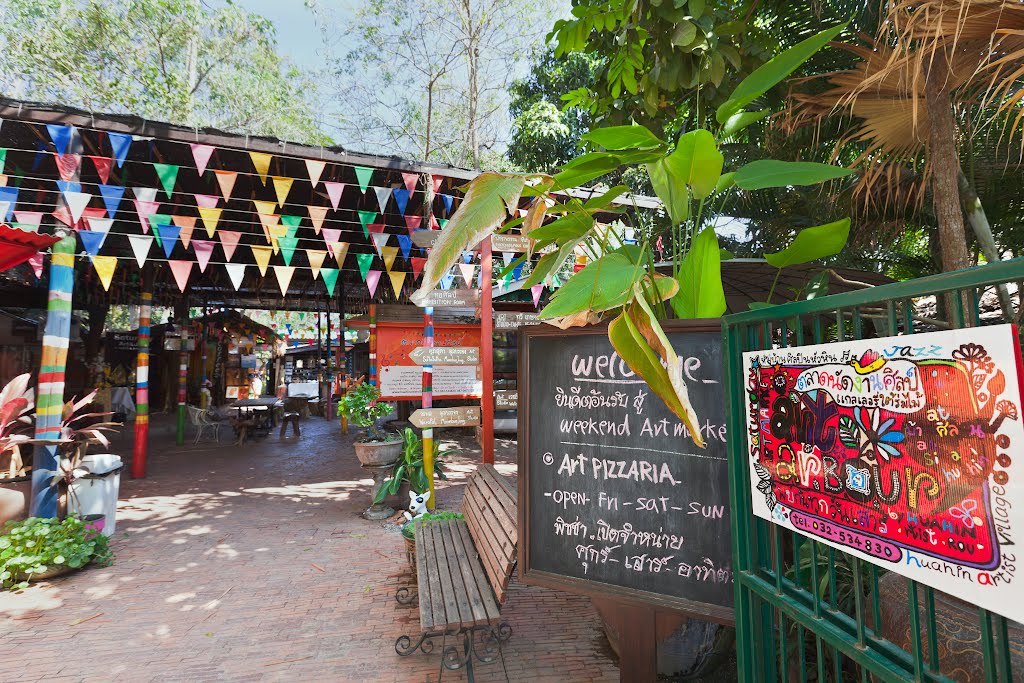
If you have a few free hours, you can take a bus for about 3 hours from the capital of Bangkok to Prachuap Khiri Khan province (in Central Thailand), visit Baan Sillapin Artists Village (also often referred to with the name easier to remember: Hua Hin Art Village, or Hua Hin Artist Village) to visit the unique art space and even be able to create your own creative products by hand. When visiting the Hua Hin Art Village, tourists feel transported back in time, where they may be creative and immerse themselves in a lyrical environment.
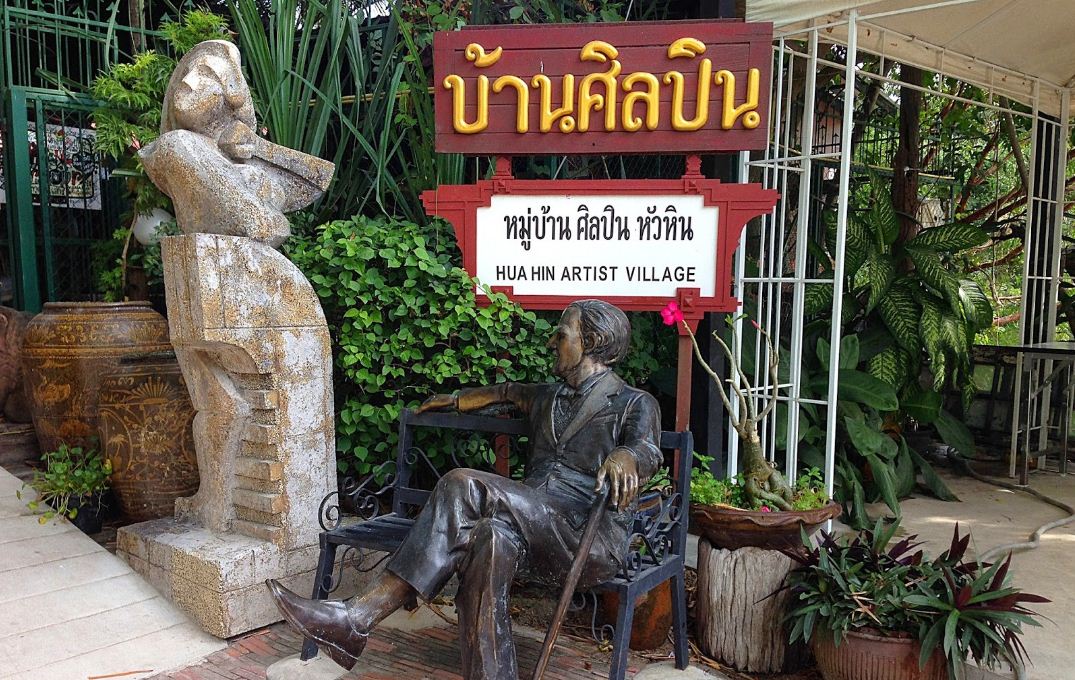
The Baan Sillapin Artists Village, founded in 1998 by watercolor painter Tawee Kesa Ngam, is the home and working location of around 19 sculptors, painters, and artists from many disciplines of art from all over the nation the Golden Pagoda, Thailand.
Artist Village is a 1.6-hectare location along the hill west of Hua Hin that was intended reserved for local artists to share art space. This location gradually became a popular tourist attraction. Visitors to Hua Hin may locate and purchase unique paintings as well as make their own works of art. This is also where many artists live and work after their exhibits in Bangkok.
Gradually, Hua Hin Art Village has become a unique place of cohesion among Thai talented artists.
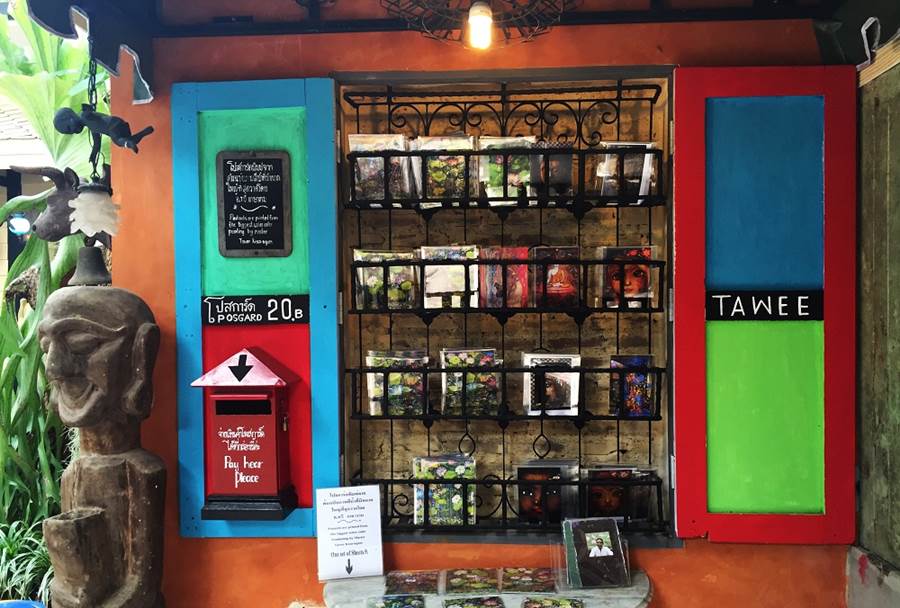
Painting is a significant field at Baan Sillapin, but artists also introduce sculpture, installation art, design, and the art of staging.
Through each artwork, the area in Hua Hin Artist Village approaches freedom of spirit and freedom of mind. Tawee Kesa-ngam, the creator of Hua Hin Artist Village, is also Thailand’s most famous painter. He and his wife intended to establish an environment where each visitor could be a genuine artist, freely return to childhood, and find themselves as a kid when the old days came.
“We’ve always wanted to build a space in Thailand for artists. Tawee Kesa Ngam stated, “Creativity is limitless, and you may enjoy in expressing your thoughts and ideas via individual paintings and artworks.” Some artists have even relocated here permanently to work on their art.
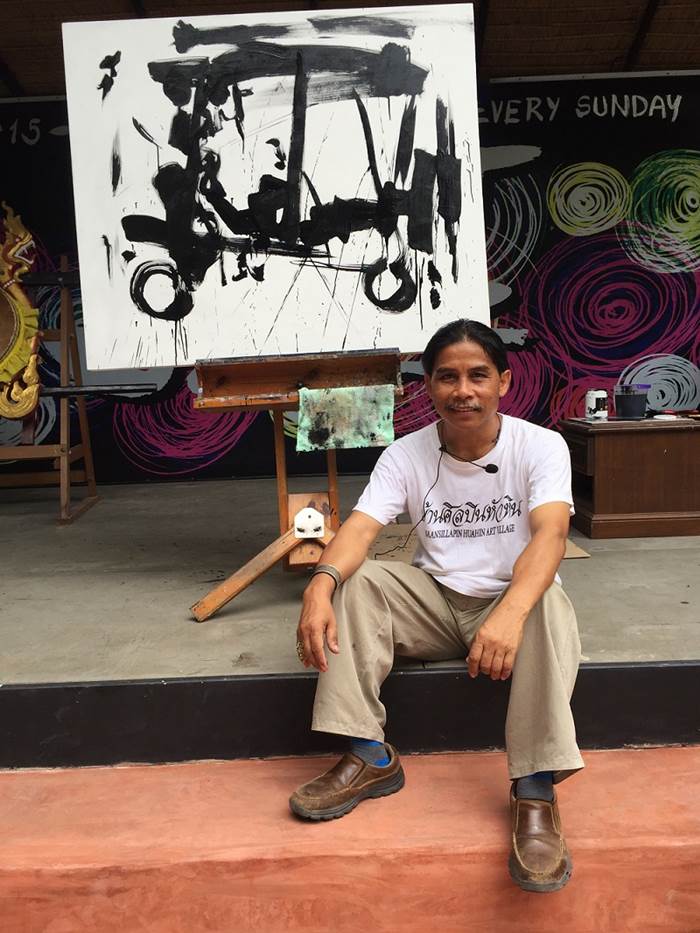
“At here, there is no teacher or student, it’s just simple a place where you can learn and try to make your own products. We will help you to do that. ” — Nang, a painter who also the workshop’s instructor said.
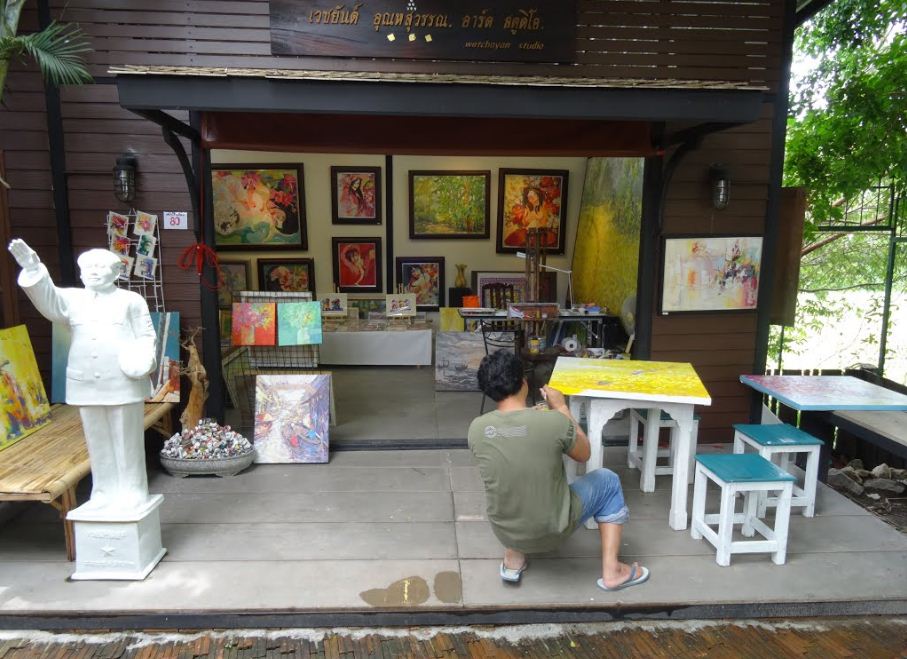
As an art enthusiast, you may visit this little “village” at any time from 10 a.m. to 5 p.m. every day from Tuesday to Sunday (Hua Hin Art Village is closed every Monday weekly), where you will be greeted by pleasant and welcoming artists.
Some interesting pictures at Baan Sillapin art village, Prachuap Khiri Khan province that Living Nomads would like to introduce to you:
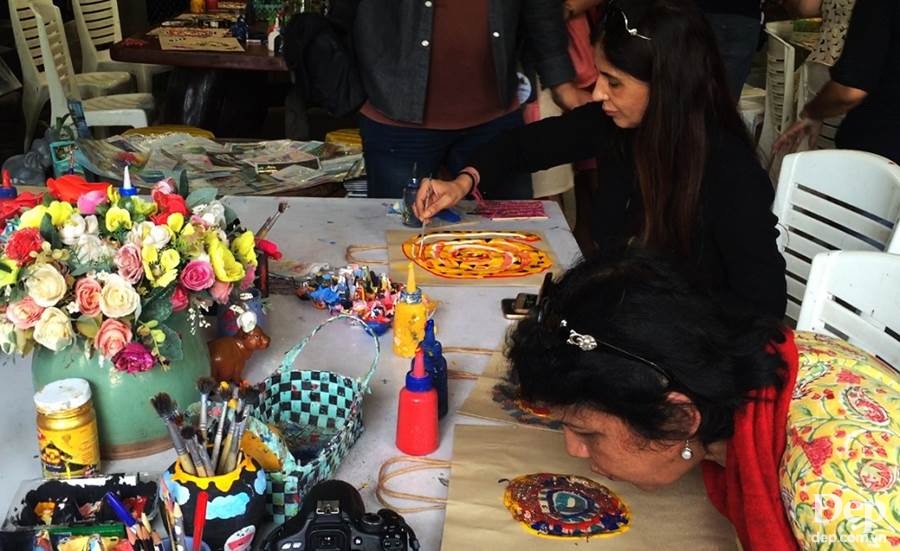
Table of Contents
Further information
“Prachuap Khiri Khan” means “the city stands among the mountains,” a province in the central region of Thailand, with the western border of Myanmar, covering a total area of about 6,368 km2, of which Hua Hin is the capital city, is also a popular tourist destination with well-known landmarks such as Hua Hin Floating Market; Hua Hin Night Market; Black Mountain Water Park, Hua Hin (The preserve and development sanctuary of mangrove forest).
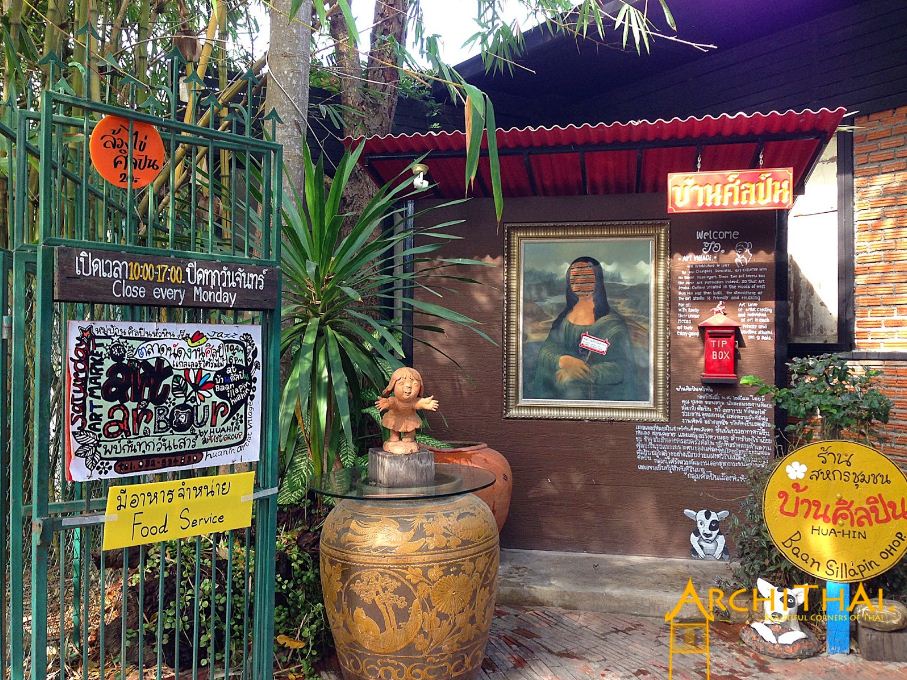
Hua Hin Artist Village
Address: 299/8 3218 Tambon Hin Lek Fai, Amphoe Hua Hin, Chang Wat Prachuap Khiri Khan 77110, Thailand Opening hours: 10am to 5pm every day from Tuesday to Sunday. Closed on every Monday weekly. Phone: +66(0)870477125 Price: Free (no entrance fee & free parking, price are subject to change). Making artworks fee: 100 bath for children and 150 bath for adults, equivalent to $US 3.5 – $US 4.5) How to get there: Located on the “Pala-U” road (route 3218) approximately 4 kilometers from the center of Hua Hin. Website: http://www.huahinartistvillage.com/ Facebook: https://www.facebook.com/huahinartvillagebaansillapin/

VietNam Tours
Throughout vietnam.
- › Vietnam at a Glance 12 Days
- › Highlights of Vietnam – 15 Days
- › Vietnam Deluxe Journey – 16 Days
Highlights in North
- › Classic Tours
- › Ha Long Tours
- › Sapa Tours
- › Ninhbinh Tours
- › Dong Tay Bac Tours
- › Hanoi Tours
- › Hagiang Tours
- › Maichau Tours
Highlights in Central
- › Hue - Danang & Hoian Tours
- › Nhatrang Tours
- › Dalat Tours
- › Quangbinh Tours
- › Ninhthuan Tours
Highlights in South
- › Saigon Tours
- › Mekong Delta Tours
- › Phu Quoc Tours
- › Condao Tours
- › Muine Tours
Indochina Tours
- › Cambodia Tours
- › Laos Tours
- › Thailand Tours
- › Myanmar Tours
- › Vietnam - Cambodia Tours
- › China Tours
- › Japan tours
- › Korea tours
- › Taiwan tours
- › Singapore tours
- › Tibet Tours
Tour related
Baan Kang Wat – Chiang Mai’s Artist Village
Northern Thailand is famous for its rich artisan culture, from woodcarving and umbrella making to handmade food items. Visit Baan Kang Wat Artist Village near Aleenta for handmade products as well as workshops and classes!
Big Ruckprasit’s village is an exquisite network of buildings designed as multi-functional houses for artists. Stroll along lush pathways amidst beautiful greenery and discover shops and studios along the way!
The Village
Northern Thailand stands out from the rest of Thailand with its distinct sense of style and creativity, evident in how people dress, speak (they should sound slower but sound fast to Bangkok ears), decorate homes and businesses – even Baan Kang Wat offers a glimpse of this vibrant creative energy! This village showcases this artistic spirit.
Chiang Mai’s Old Historical Town lies outside this village and offers an oasis of culture and craftsmanship. Wander its lush pathways lined with blooming plants as you visit its shops, studios and restaurants – many traders also provide workshops on various subjects ranging from pottery making and painting to leathercraft and jewelry-making!
Nattawut Ruckprasit, more commonly known by his artistic moniker Big, has achieved an enviable balance between nature and development in this village. Grass and trees cover its property while teak houses built in traditional-meets-modern style feature brushed concrete walls and timeless wooden furniture; artists and craftspeople live above their shops creating a sense of community among residents; Big’s personal artistic practice can be traced through his aesthetic choices including palm-sized ceramics that highlight his balance between clay and wood.
Baan Kang Wat is a favorite dining and shopping hub of both locals and visitors, both alike. Offering everything from vegetarian fare to meat dishes at its cafes and restaurants, vegetarians won’t go hungry here. Taiwanese Veggie Restaurant on Nimmanhaemin Soi 13 provides one such spot; another great vegan food choice can be found nearby at Mae Ping Street Food Stalls.
Baan Kang Wat offers more than art; it provides a welcome respite from downtown Chiang Mai’s busy streets. Each teak and concrete house, or house, houses its own trader with something exclusive to offer; many even run workshops so visitors can learn something new or leave with personalized souvenirs!
Nattawut Ruckprasit, commonly known by his Thai moniker Big, was inspired to create Baan Kang Wat by his own artistic practice: creating palm-sized ceramic sculptures made with clay and wood that carefully balance out each element. Baan Kang Wat houses reflect this aesthetic with each home featuring both indoor and outdoor spaces used for designing, making, exhibiting, selling, learning and living; Big’s Bookoo Studio can be found inside one home along with many independent shops and restaurants.
Each house is carefully planned to take advantage of natural lighting, ventilation and insulation; creating beautiful yet inviting living spaces where people can sit back with coffee or tea and relax in comfort.
Baan Kang Wat shops feature an assortment of locally made goods, from clothing and accessories to jewellery and gifts for loved ones back home. You are sure to find something suitable at one or all of its shops!
Alongside its shops, the village also features a small cafe and workshop space where you can try your hand at pottery- or fabric art making. Please be aware that these workshops tend to fill quickly; so, if you’re keen on learning something new be sure to book early.
Baan Kang Wat is open daily from 11:00 a.m. – 6:00 p.m, though individual shops have different opening hours. Easily found and worth the short drive out from town, it offers peaceful respite from city streets while offering authentic local craft and cuisine in an immersive and unique setting.
Baan Kang Wat Village lies at the base of Doi Suthep and prides itself on sustainable and community based practices. Each shop in this village is owned by independent local artisans who operate under a common economy system to reduce rent payments while directly engaging their customers.
Each store and stall in a village is special, reflecting its owner’s creativity and craftsmanship. Some stores specialize in handicrafts while others offer more general items like pottery or clothing; some even run workshops to introduce visitors to local crafts while teaching something new!
Cafes and restaurants across Thailand also provide an array of cuisine from all corners. Their offerings use fresh local ingredients with creative flare – an excellent opportunity for travelers to try new Thai dishes while supporting artists within their communities.
Village itself is an idyllic destination, especially during morning hours when temperatures are more pleasant and not so crowded. A central sunken amphitheater hosts local events like musical or gaming tournaments which further add to its unique spirit. Meanwhile, buildings crafted out of teak wood and concrete provide stunning scenery.
Baan Kang Wat is an indispensable place if you want to support local artisans and gain an insight into community life in Chiang Mai. There’s so much going on at Baan Kang Wat that spending hours here won’t become tedious; make sure this visit is part of any itinerary in Chiang Mai and don’t miss it!
Village located just outside the Old Historical City and easily reached via tuk tuk. Ask for Baan Kang Wat (Black Temple Market) near Wat Ram Poeng (wadrameping).
Nattawut Ruckprasit, commonly referred to by his nickname Big, first had the idea for an artist village in 2009. Several years were spent planning this ambitious endeavor before ground was broken in 2014. Big’s designs combine traditional Northern Thai architecture with contemporary approaches while providing both living quarters and workspaces within each building.
While most village houses are used for artisanal production, each space has been carefully planned to facilitate a range of activities from designing and painting to teaching and selling. Big has carefully chosen all retailers, food service providers and service providers in his village who share his philosophy of creating a shared economy that benefits all. Tenants range from handicraft stores and family restaurants to traditional barber shops – even an old-school barbershop!
Make sure to allow at least a couple hours for you to explore and discover all that the village has to offer. Many traders provide workshops or classes such as pottery or woodworking which you can participate in, as well as offering unique handmade products at different shops and studios throughout.
An amphitheater near the entrance serves as the venue for various community events throughout the year, such as live music performances and educational talks. These gatherings aim to connect local residents with both their environment and each other more intimately.
Other events held at the village include ceramic workshopping sessions hosted by In Clay and Chatchaiwat Pottery; as well as tie dye workshops facilitated by artists Pawana (Nok) Prakobsuk of denim brand Like Now who demonstrate how to tie dye textiles using natural colors such as indigo for blue tint and blood-orange annatto seeds for red hues.
Baan Kang Wat’s artists and shop owners take great pride in the craftsmanship and quality of their products, which can be seen by visitors who visit this village of Chiang Mai. Baan Kang Wat stands as a hidden gem ideal for creative exploration in Chiang Mai.
Related Posts
Santichon village, northern thailand, double takes: taz ah mugs doi ang khang style, double takes: notes from the road: northern thailand, chiang mai.

Ubud Art Village Tour
Ubud art village tour is a popular activity for visitors to Bali, Indonesia, Ubud art village tour is full day tour 8 hours for those who are interested in exploring the region’s rich artistic and cultural heritage. The tour typically includes visits to several traditional art villages in and around Ubud, where visitors can observe local artisans at work and purchase unique handmade crafts. Here is a suggested itinerary for an Ubud art village tour:

Tripadvisor Reviews
Ubud Art Village Tour Itinerary

Batubulan Village

Tohpati Village
Tohpati Village, located in Bali, is renowned for its exquisite Balinese Batik, which displays stunning designs and vibrant hues. Visitors have the opportunity to witness the intricate craftsmanship involved in this ancient art form. Batik, a traditional fabric painting technique with distinct motifs, originated in Indonesia. Tohpati Village is conveniently accessible, situated just 12 kilometers away from Ubud. It serves as a popular destination for tourists after enjoying the captivating Barong dance in Batubulan Village. Tohpati holds a significant position as the main hub for batik production in Bali, effectively showcasing the Balinese people’s rich artistic heritage. During your visit, make sure to explore the workshops, learn about traditional techniques, and peruse the wide range of batik fabrics and products available for purchase.

Celuk Village
Celuk Village, in Gianyar Regency, is famous for gold and silver handicrafts. It’s often included in Ubud art village tours due to its proximity. Known as the “silver village,” Celuk produces intricate jewelry showcasing craftsmanship. It’s located near Sukawati, about 3 miles from the coastal bypass. Celuk’s artistic heritage dates back to the 1970s when the industry flourished. Today, it’s a hub for unique silver and gold jewelry. Explore workshops, witness crafting process, and purchase exquisite jewelry as souvenirs or gifts.

Art Painting Village
Batuan Village is renowned for its Batuan paintings, a significant Balinese artistic style. It has art galleries and cooperative art societies promoting Batuan art. Located in central Bali, it is south of Ubud and northeast of Denpasar. It borders Sukawati village, another famous art center. Batuan Village is famous for the Puseh Batuan Temple, showcasing traditional Balinese temple architecture. The temple is a popular destination for cultural and temple tours. When planning an Ubud art village tour, include a visit to Batuan Village to appreciate the paintings, explore the temple, and browse art galleries.

Mas Village
Mas Village, situated in the enchanting town of Ubud, is famous for its exceptional craftsmanship in Balinese woodcarvings. Moreover, this captivating village has a storied past and a legacy of creating intricate sculptures inspired by the captivating mythologies of Hinduism and Buddhism. Additionally, from the 1970s to the 1990s, Mas gained international acclaim for its timeless Balinese art style, solidifying its reputation as a hub for artistic excellence. Furthermore, conveniently located in southern Ubud, just 5 kilometers from Ubud Center and a short 20 kilometers from Denpasar airport, Mas Village attracts visitors with its proximity and allure. Notably, it is surrounded by other prominent art villages such as Celuk, known for its masterful silver and gold crafts, Sukawati, renowned for its vibrant traditional market, and Batubulan, where mesmerizing dance performances captivate audiences.
- Price USD 38 / IDR 500.000/CAR
- 09:00 – 17:00
- Price includes a private car suitable until 7 persons
A Place To Visit in Baguio Filled with Arts and Gastronomy—Ililikha Artist Village!
Ili-likha artist village, a must-place to visit in baguio, is truly a work of art.

Explore Baguio City’s culture, arts, and food at this hidden gem, Ili-Likha Artist Village.
It Features the Nature and Culture of Baguio through Artwork

Ili-Likha Artist Village is a work of art from exterior to interior.

Arty vibes fill in this village in all its glory.
The Gastronomic Scenes You Shouldn’t Miss

This artistic community offers many reasons to turn your attention everywhere—including food!

Cafe Cueva's best sellers include Lechon Macau, Honey Glazed Ribs, Organic smoothies, and their original Tuna crepe with organic greens and yogurt sauce.

Rstpst and siopots are some of Scout Burrows’ specialties.

Kapi Kullaaw has everything you need for your coffee cravings, from hot to cold drinks to cold ones.

Fill your guts with healthier Filipino favorites at Waynu

Yomichee’s snack platter has cottage cheese dumplings and potato cheese sticks, a healthier version of your favorite snacks. They also have delicious yogurt bowls

Nourish your belly, body, and mind with Little Milkyway’s handcrafted vegan burgers and probiotic drinks.

Pomodoro pasta and Full Hunter’s meal are Leandro’s Bistro best sellers.

Copper Fusion’s garlic longanisa meal and salted egg chicken are a must-try.
What’s More? It’s A One-stop Shop for Proudly Pinoy Items with a Culture of Baguio

Find everything and anything you’ll love and need at these shops at Ili-Likha Artist Village.

Inside the Anthoniuz Floral Design Shop

- Register My Store
- Submit My Favorites
- Terms and Conditions
- Privacy Policy
- HTML Sitemap
- XML Sitemap
- A Travellers Guide To Baan...
A Traveller's Guide to Baan Kang Wat

Baan Kang Wat is a charming little artist village, set just outside Chiang Mai’s old historical town. It is located at the base of Doi Suthep mountain, not too far from Wat Ram Poeng Temple.
The village itself is comprised of approximately 10 buildings, and as you wander through the small lush pathways you’ll find a variety of independent businesses. Each individual shop is tastefully decorated; inside, you’ll find anything from wooden cut boards to ceramic cups, clothes, and a large collection of home décor items. Some of the artists offer classes and workshops in their studios, which visitors are welcome to join.

The original idea for Baan Kang Wat emerged and flourished from a wish to create a space for local independent artists to run their own businesses and workshops. The intention was to promote local artisans and local culture. At the heart of the artist village lies a love of art and handcrafted products , as well as a deep desire to re-establish a sense of community and a purposeful network of like-minded individuals.

As you make your way through the little neighborhood, you’ll notice that all the buildings in Baan Kang Wat follow a similar aesthetic theme – a tasteful mix of traditional Thai architecture (evident through the use of wood) mixed with some modern designs and minimalistic features. The idea was to blend together modern Chiang Mai city designs with concepts of sustainability by gathering inspiration from nature. This natural integration is visible in the flourishing greenery stretching along the sides of the buildings. Flowers, plants and shrubs of all kinds seem to be embedded into every corner and space of the village. There is even a little organic garden towards the end of the communal space. This perfect blend between the modern and traditional Thai lifestyles accentuates the village’s overall quirky and laidback vibe.

A small amphitheater sits near the entrance of the village surrounded by several of the artist’s houses and shops. This open space is used for a variety of community events, such as film screenings and live performances that take place throughout the year.

Every Sunday, the village hosts an open market from 8 a.m. to 1 p.m. Aside from Mondays, when shops are closed, Baan Kang Wat is open to visitors every day from 11 a.m. to 6 p.m.

It’s only about a 10-minute drive to reach Baan Kang Wat if you’re coming from the west side of the old city. As it’s a little out of the way, the easiest way to get there, if you don’t have your own means of transportation, is by tuk-tuk or songthaew , which are always easily accessible from the city center.

Become a Culture Tripper!
Sign up to our newsletter to save up to $1,200 on our unique trips..
See privacy policy .

If you’re looking for something to do in Chiang Mai on a lazy Sunday afternoon, Baan Kang Wat is the perfect place to relax, recharge and reconnect to what really matters: being together, appreciating those little moments that make up the whole of our lives, and indulging in a scoop (or three) of some home-made ice cream.

A Guide To Suvarnabhumi Airport (BKK), Bangkok

20 Best Places to Visit in Thailand

Essential Phrases You'll Need in Thailand

The 21 Best Dishes to Eat in Thailand

A Guide to Using Bangkok's BTS Skytrain

The 8 Weirdest Attractions to Visit in Thailand

The 15 Most Beautiful Beaches in Thailand

The 19 Best Attractions in Thailand

Things You Should Know About Thai Culture

A Guide to Chatuchak Weekend Market

When and How Much to Tip in Thailand

The 12 Best Family-Friendly Destinations in Thailand
Culture Trip Summer Sale
Save up to $1,200 on our unique small-group trips! Limited spots.

- Post ID: 2196723
- Sponsored? No
- View Payload
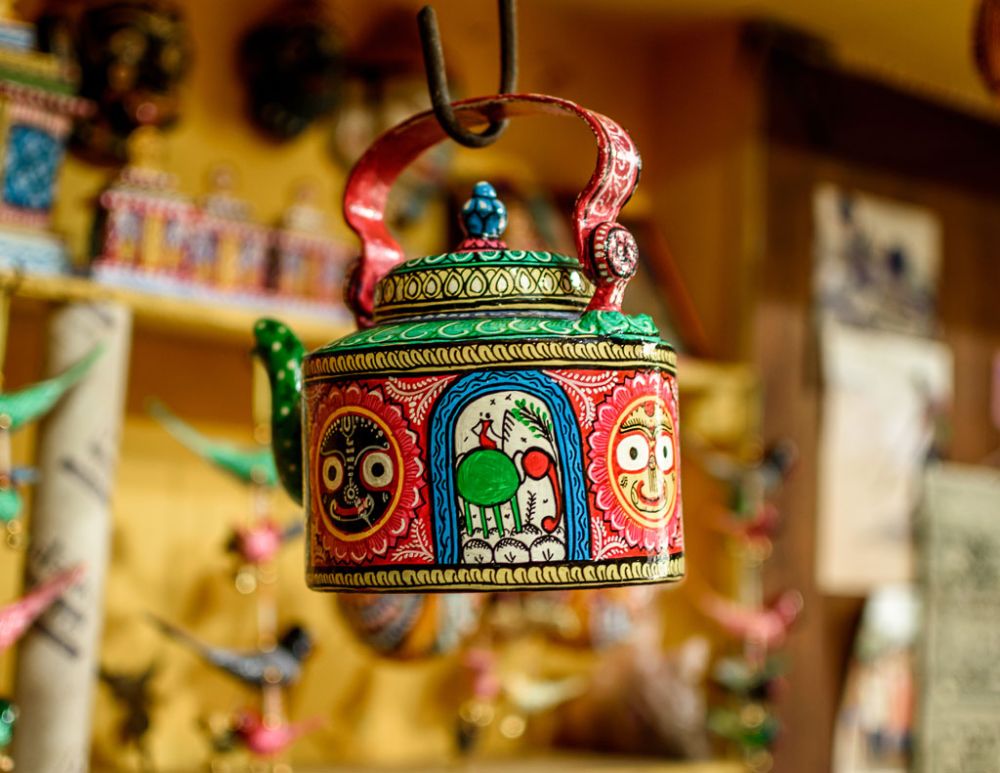
Raghurajpur Artist Village Tourism
- Raghurajpur Artist Village
- Best time to visit
- Tourist Map
- within 25kms
- within 50kms
- within 100kms
- within 150kms
- within 200kms
- within 250kms
- within 300kms
- within 500kms
Opening and Closing time of Raghurajpur Artist Village
Disclaimer: It's important to check the most current information before planning your visit, as opening hours can vary and might be subject to change due to special events, maintenance, or unforeseen circumstances. A reliable way to confirm the opening hours is to contact the local tourism board, check the official website (if available)
Entry Ticket Pricing for Raghurajpur Artist Village
Disclaimer: Please note that prices are subject to change, cross check required .
Tips when you are visiting to Raghurajpur Artist Village
Other Suggested Reads for Raghurajpur Artist Village
- Best time to Visit in Raghurajpur Artist Village
- Raghurajpur Artist Village Tourism History
- FAQS about Raghurajpur Artist Village
- Raghurajpur Artist Village Tourist Map
- Tour Enquiry
- Sign up | Login
- My Bookings
- New User? Sign-up
- Domestic Tours
- South India
- Maharashtra
- Golden Triangle
- North India
- North East India
- International
- Maldives (Discontinued)
- All Domestic Tours
- All International Tours
- Offbeat Tours
- Domestic Cruise Tours
- Jungle Lodges by JLR
- Kabini River Lodge
- Bandipur Safari Lodge
- JLR Kings Sanctuary
- River Tern Lodge
- Kali Adventure Camp
- Hampi Heritage & Wilderness Resort
- K Gudi Wilderness Camp
- Car Rentals
- Destinations
- Tourist Places on Drive
- Driving Directions
- * Workation
- * Tour Plans
- List Property
Please wait... the destination details are being loaded
- Gujarat Tourist Places
- Places to Visit in Saputara
- Artist Village
Artist Village, Saputara - Timings, Entry Fee, History & Artifacts
India | Gujarat | Saputara
#6 of 20 places to visit in saputara, distance (from saputara bus station): 1 kms, visited from: saputara museum (300 m), trip duration (including travel): 30 mins - 1 hr, place location: opposite saputara lake, transportation options: cab / walk/trek, website: na, phone no: na, place address: na, travel tips: none.
At a distance of 1 km from Saputara Bus Station, Artist Village is a magnificent place to see and buy tribal artifacts in Saputara, Gujarat. Situated opposite to Saputara Lake, it is one of the must visit places in Saputara. Artist Village, popularly known as Gandharvapur artist, is a lovely spot afloat with beautiful artefacts. Run by Surya Goswami and Chandrakant Parmar, it is regarded as the cultural and traditional center of the region. It exhibits spectacular artifacts of the native tribes that include bamboo craft, warli paintings, jewellery and pottery etc. Artist Village is a good place not only to see and buy artefacts but also to get your hands to work and learn about the culture of this region, especially for school groups. Artist Village in Saputara is also popular amongst arts schools that organize various workshops for teaching their crafts. Students of fine arts often visit the village to pick the shades of the craft and get hands-on knowledge about the state of the arts in India. The village also provides simple accommodation for a very reasonable cost. Timings: 9 AM - 7 PM Entry: Free
6 Must Visit Places in Saputara
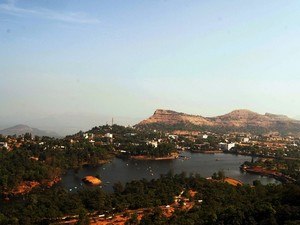
Other Places to Visit in & around Saputara
Top 3 saputara tour packages, most popular tours, saputara related pages.

100% SECURE PAYMENTS
Domestic & International Cards Accepted

Our WhatsApp Numbers
Kerala, Tamilnadu, AP & TG Tours
Karnataka Tours
Goa, Maharashtra, Gujarat Tours
North India Tours
Rest of India
International Tours
Request Quote
Travellers #
Explore Tour Packages
Discover Affordable Tour Packages
Need Customized Tour? Request Quote
Login / sign-up.
Your Sign in was successful! Itinerary will be downloaded shortly.
Sign up with Trawell.in
Already Created Account? Login Here
Sign in with Trawell.in Account
Forgot Password?
New User? Sign Up Here
Activate Your Trawell.in Account
Your account is activated successfully. Login Here
Reset Your Trawell.in Password
Your password has been reset successfully. Login Here
Booking Policy
Raghurajpur Artist Village
Raghurajpur artist village, puri overview.
Raghurajpur village is a heritage crafts village near Puri, known for Pattachitra paintings, as well as other art forms like palm leaf paintings, wood and stone carvings, papier mache, masks, coconut crafts, and Gotipua folk dance, the predecessor of classical Odissi dance style. The village is also the only place where the traditional decoration for Lord Jagannath's throne, called Patas, is made. The art-enriched village owes its culture to an era as early as 5 BCE.
In 2000, Raghurajpur was honored as a 'heritage village' by the Indian National Trust for Art and Cultural Heritage (INTACH), fostering a renaissance of traditional art forms among its artisans. Both men and women actively engage in this artistic pursuit. These artisans warmly welcome visitors, readily sharing insights into the art's origins and techniques. Many families graciously open their homes to guests, offering direct purchases of their creations. For a deeper experience, visitors can even partake in lessons offered by the artisans for a separate fee. As you explore this vibrant artistic haven, take a moment to honor the legacy of Guru Kelucharan Mohapatra, a celebrated luminary of Odissi dance whose roots trace back to Raghurajpur.
Top Hotel Collections

Holiday Homes
Beach Hotels
Beach Resorts
Cheap Hotels
5 Star Hotels
Top Hotels Near Raghurajpur Artist Village
7.8 (541 reviews)
8 kms
₹ 3,300 onwards
7.3 (293 reviews)
9 kms
₹ 4,000 onwards
8.6 (225 reviews)
10 kms
₹ 3,149 onwards
5.9 (202 reviews)
₹ 3,773 onwards
8.3 (170 reviews)
₹ 8,200 onwards
6.5 (169 reviews)
₹ 3,838 onwards
Raghurajpur Artist Village Reviews
Sanjeev Khatarkar
Have a Question on Raghurajpur Artist Village?

Other Top Ranking Places In Puri
Nearby places.

Related Posts

Beaches & Islands
Beautiful Beaches in Puri

Magnificent Temples in Puri for a Divine Piligrimage

Best Water Parks in Puri for a Fun-filled Day-out

Things to Do in Puri

Art & Culture
11 Astonishing Facts About Jagannath Temple In Puri

Places to Visit near Puri

Food & Drink
Delicacies from Local Food in Puri For A Delicious Treat!

Jagannath Puri Rath Yatra 2024 : Dates and Details
Similar Places

Get the best offers on Travel Packages
Compare package quotes from top travel agents
Compare upto 3 quotes for free
- India (+91)
*Final prices will be shared by our partner agents based on your requirements.
Log in to your account
Welcome to holidify.
Forget Password?
Share this page
Your browser is not supported for this experience. We recommend using Chrome, Firefox, Edge, or Safari.
- Stories to Inspire Your Travel
Kayenta Art Village
Like a Marfa, Texas, or Paonia, Colorado, Kayenta is often regarded as an artist colony of sorts. Kayenta's Art Village is a hub of cultural and social activity for locals and visitors alike.
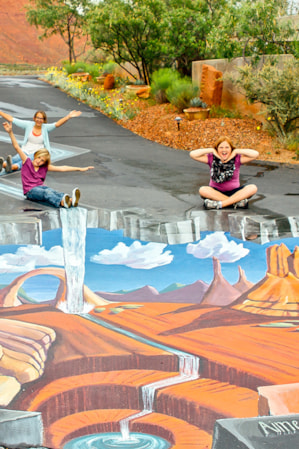
Photo: Austen Diamond Photography
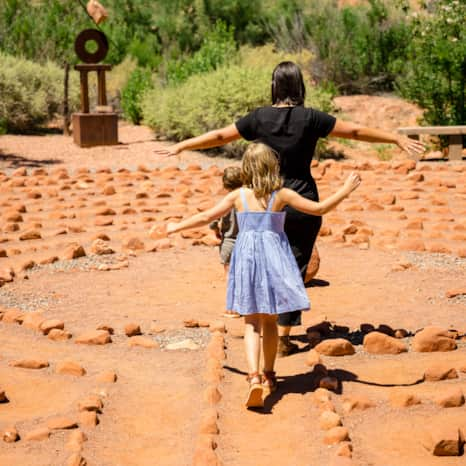
Kayenta Desert Rose Labyrinth
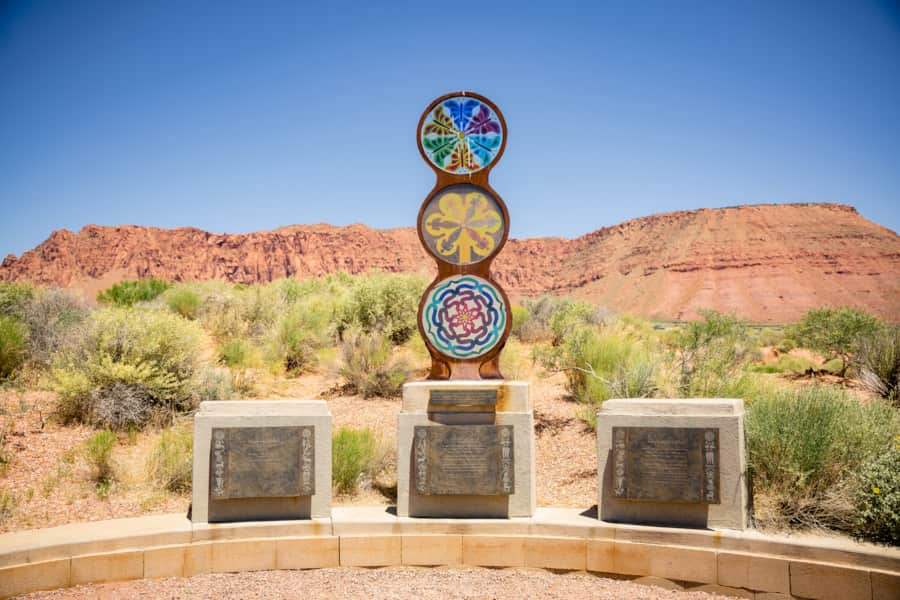
Art installation at Kayenta Art Village
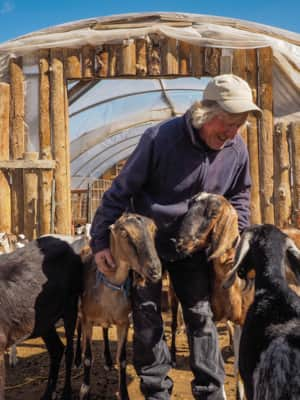
Utah’s Unexpected Pit Stops
Written By Melissa McGibbon
5 minute read
You’re doing it wrong if you think road trip pit stops are boring layovers on your way to more exciting destinations. How many of these hidden gems have you been to? Here are 11 mini-adventures to check off your list next time you’re road-tripping through Utah.
Hiking, Food & Drink, History, Dinosaurs, Scenic Drives, Arts, Road Trips, Support Local, Adventure, Responsible Travel, Agritourism, Native American

Discover More
Previous Group Next Group
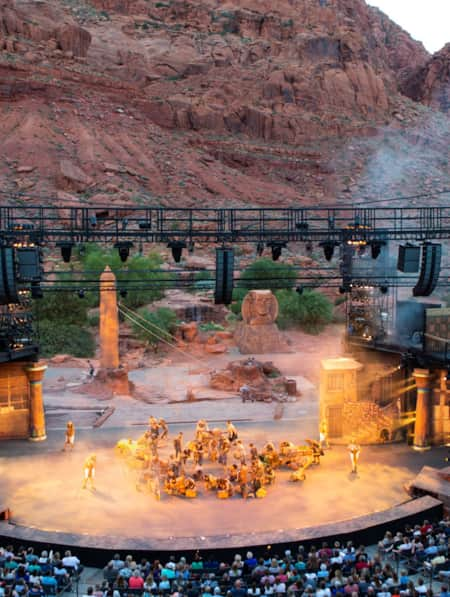
Discover an Outdoor Stage in Utah's Canyon of the Gods
Written By Katya Wagstaff
Tuacahn Amphitheatre enhances its productions with natural red rock landscapes
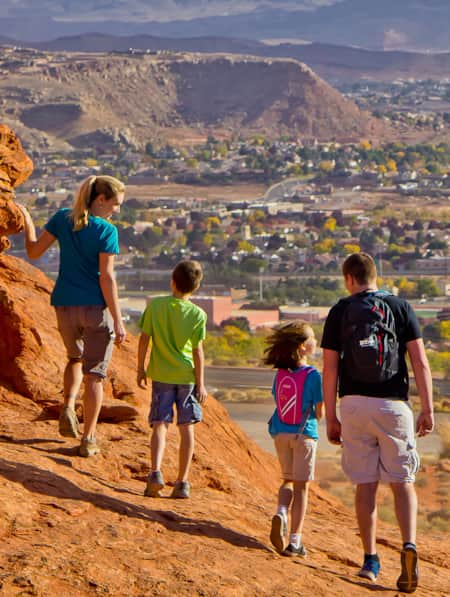
Basecamp St. George
Written By Elainna Ciaramella
Get to know the biggest city in Greater Zion, a great basecamp for Zion National Park, as well as four state parks.
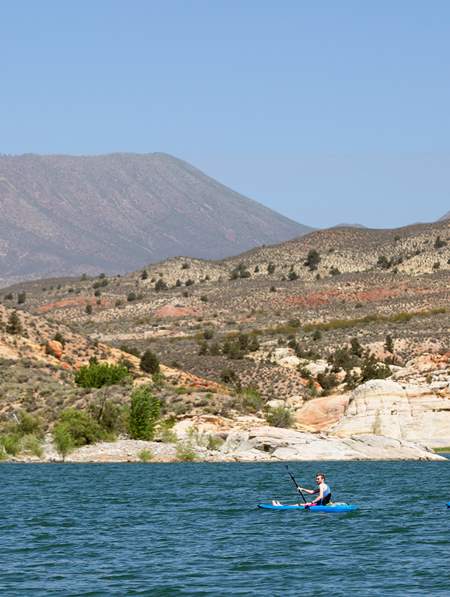
Paddle Among Red Rocks and Waterfalls at Gunlock Reservoir State Park
Written By Matcha
4 minute read
Pack up your gear and head out to Gunlock Reservoir near St. George. Bring your SUP, kayaks, jet skis and power boats for a day full of watersport excitement.
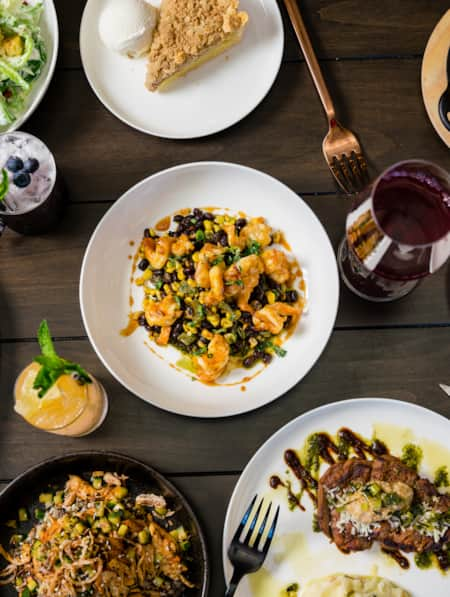
Where to Eat and Drink in St. George
6 minute read
As you explore St. George and Greater Zion seeking excellent food, coffee and drinks, you’ll want to add these top restaurants to your list.
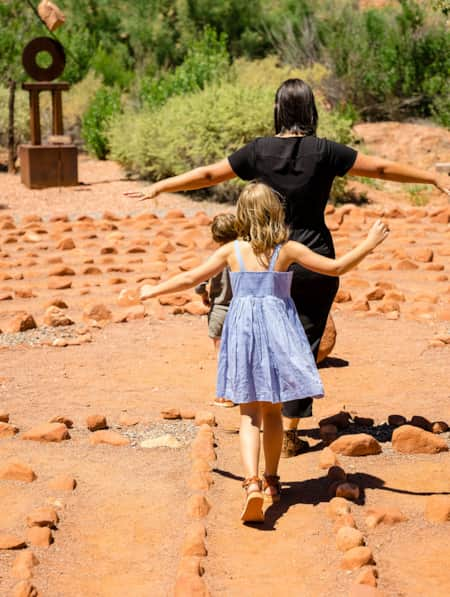
How to Experience the Thriving Arts & Culture of St. George
St. George, Utah has transformed from gateway town to booming art hub. And whether you visit for theater amidst the red rocks or the galleries of Kayenta, you’ll find a big-city scene coupled with small-town charm.
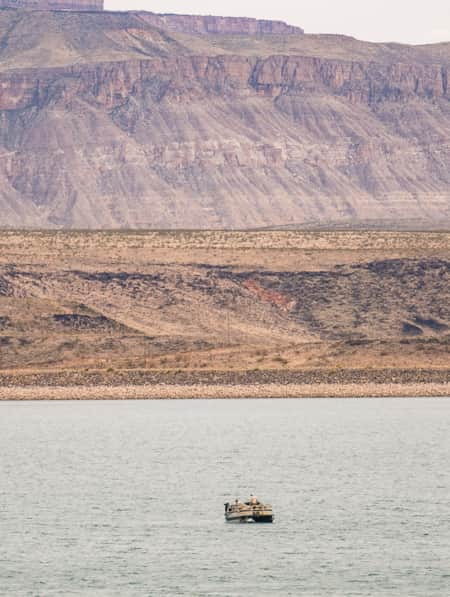
How to Have the Perfect Weekend on the Water at Quail Creek State Park
Just 15 miles north of St. George and even closer to the town of Hurricane, Quail Creek State Park offers warm water and mild weather year round. There’s plenty to do out on the water, and the gorgeous setting is sure to impress.
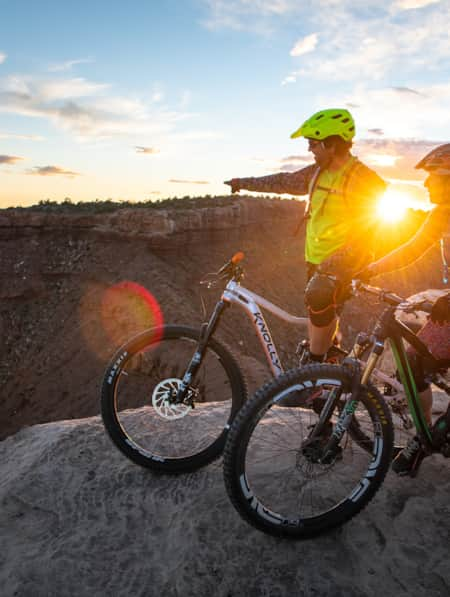
Mission to Mars: Riding Gooseberry Mesa
2 minute read
You haven’t truly ridden a mountain bike until you’ve visited the stunning slickrock of Gooseberry Mesa. Learn more about this spectacular Utah trail.
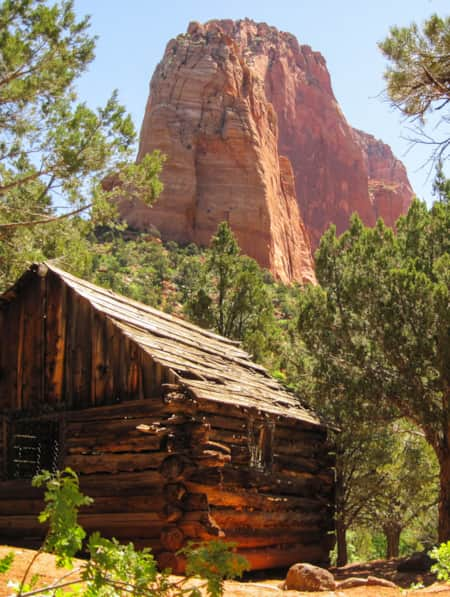
A Visitor's Guide to Zion's Kolob Canyons
In the Kolob Canyons section of Zion National Park, you’ll find a scenic wonderland with an adventure for everyone. Learn more about this unforgettable attraction and plan a visit.
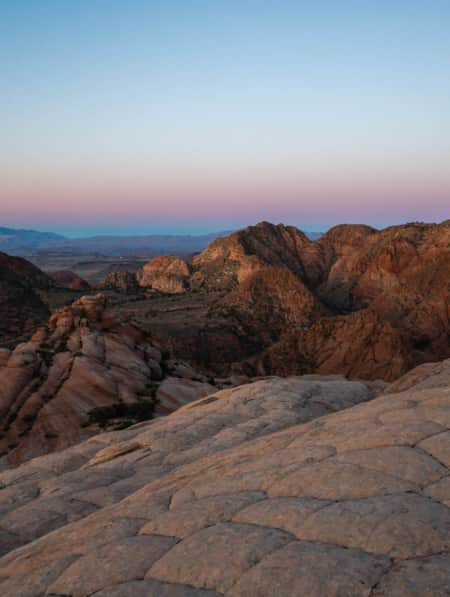
Best Hikes in St. George During Winter
While Utah's Greater Zion offers a few hundred trails, we’ve highlighted seven of the best hikes in the state's southwestern corner, from deep canyons to high peaks.
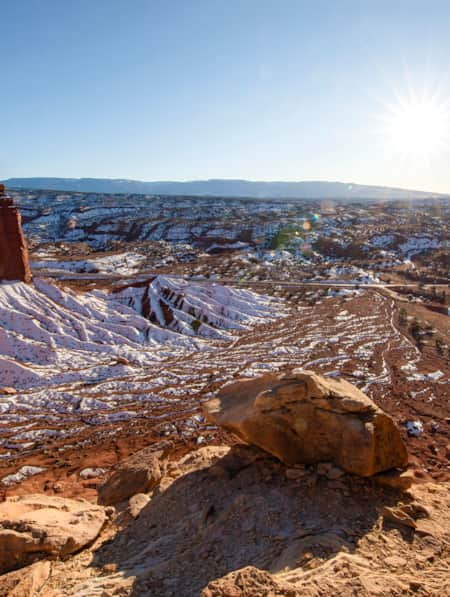
A Winter’s Desert: Visiting Southern Utah in the Slow Months
Written By Brinley Froelich
7 minute read
Experiencing the peace of canyon country in the winter is an attraction of its own.
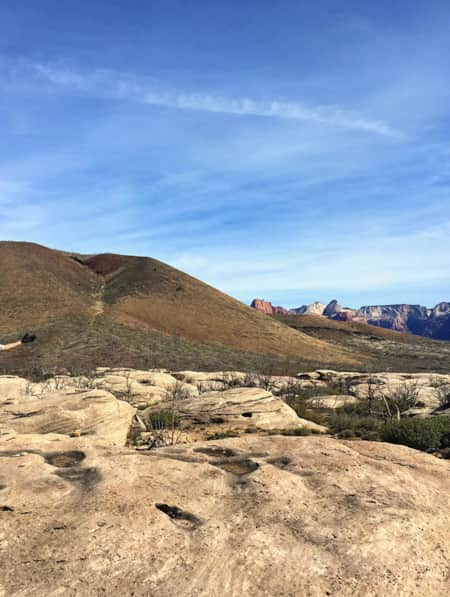
Ridin' Greater Zion
Southeastern Utah might be the state’s hidden gem of mountain biking. Learn about the top mountain biking trails in this area and plan a getaway you’ll never forget.
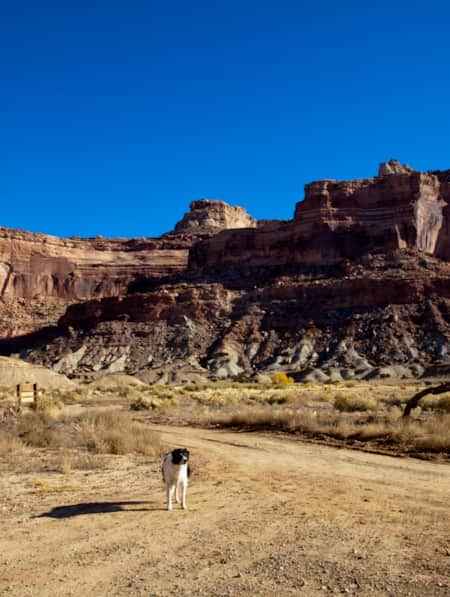
Dog-Friendly Utah: The Road to Mighty
Written By Visit Utah
Want to bring your furry friend on your next vacation? Utah is home to several great dog-friendly national parks and other fun destinations. Check it out and plan your trip!
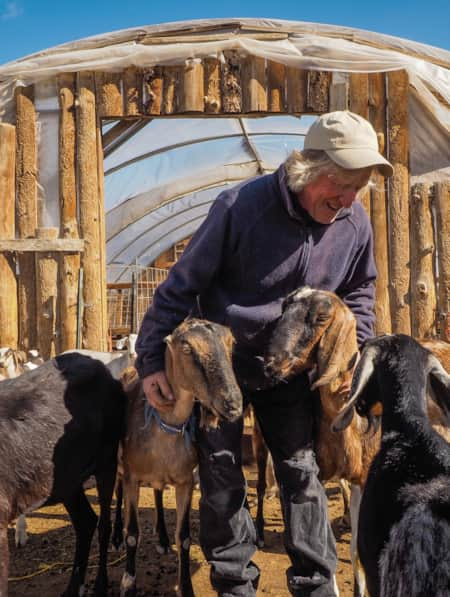
The Art of Supporting Utah Artists
Written By Lindy Blanchette
Here’s a look at six local artists whose work draws upon Utah’s diverse environments as inspiration.
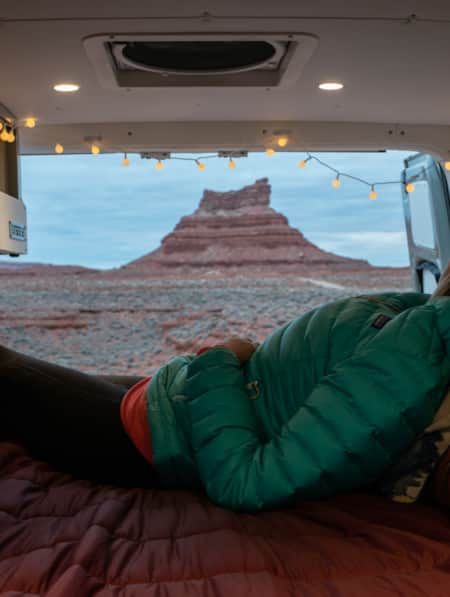
A Van Lifer’s Guide to Responsible Travel in Southern Utah
Written By Kristen Bor
When Utah’s dirt roads are calling you, it’s time to plan your van life road trip. Here’s what you need to know to travel safely, support Utah’s rural communities, and help preserve the delicate desert landscapes.
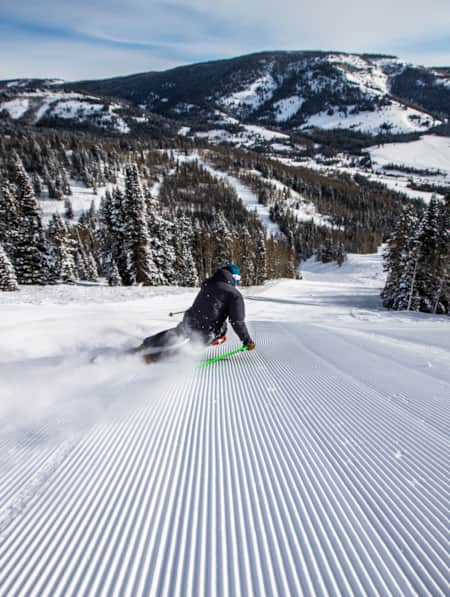
Max Out Your Multi-Pass
Written By Paula Colman
With so many ski and snowboard resorts easily accessible in and around Utah, using the state as your gateway can maximize the value of any multi-pass. Here's some tips on how to make your ski vacation more flexible, fun and affordable than ever before!
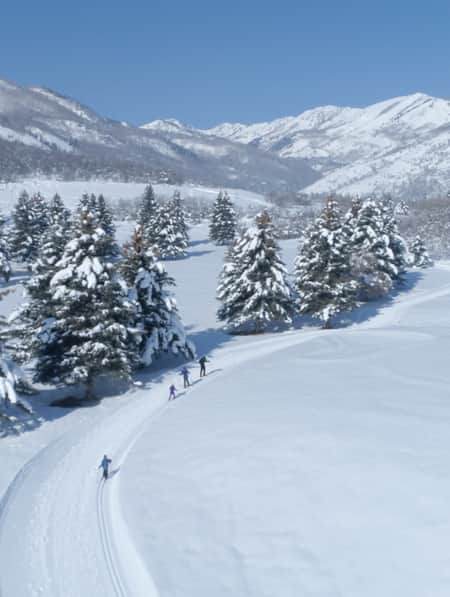
Find a Winter Refresh in a Utah State Park
Written By Rosie Serago
The best Utah state parks will entice you with ice fishing, white sand and snow-dusted scenery. Take a winter break to refresh with a visit to a few of these places.
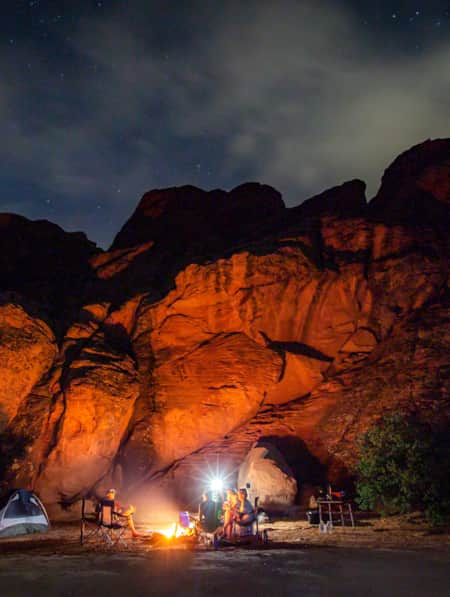
It’s About Time We All Unplugged
Written By Megan Michelson
After months of being at home, we’ve all been disconnected from each other but connected permanently to our screens. It’s time to pull the plug—literally. In Utah, you can find far-flung places to reset, wellness resorts that promote digital detox, and destinations where you can swap screen time for much-needed adventure time.
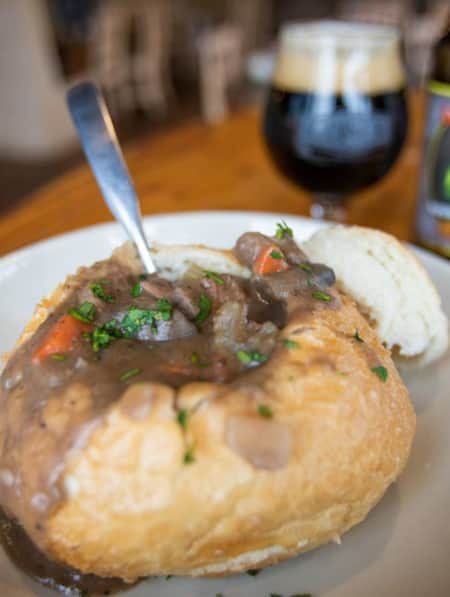
5 Utah Dinner Recipes to Try at Home
Fill your dinner plate with a taste of #UtahFromHome.
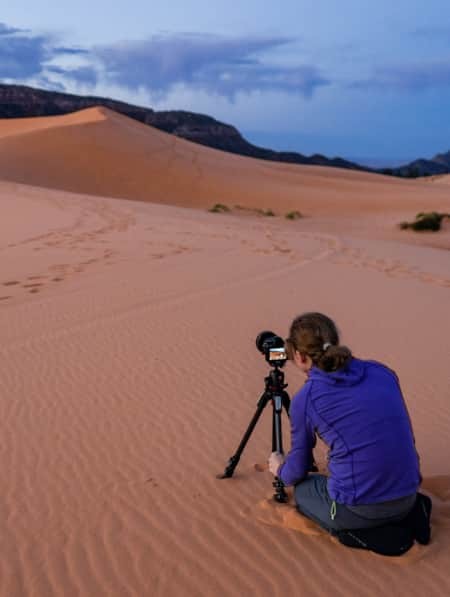
Desert Shutter Speed
Written By Jeremy Pugh
10 minute read
After lunch isn't the prime time to head to the desert. Come early or late, and Utah's deserts will reward you with their isolated landscapes, sunrises and sunsets, and stargazing opportunities.
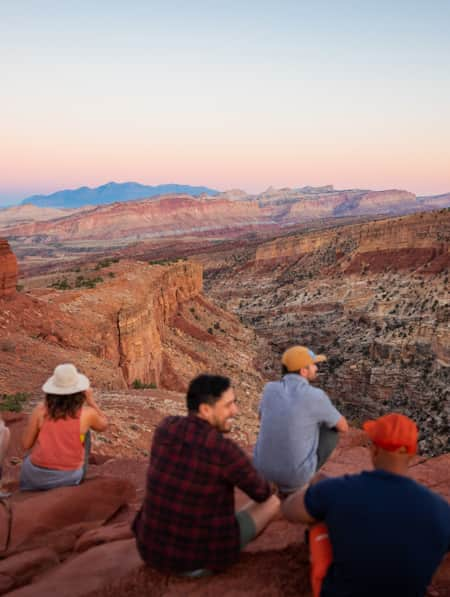
Planning Ahead for Your Utah Adventure: Outdoors Tips for Three-Season Fun
Written By Austen Diamond
3 minute read
Before you plan your Utah outdoor adventures, check out our guide to proper preparation. You’ll enjoy your action-packed travels even more. Read now!
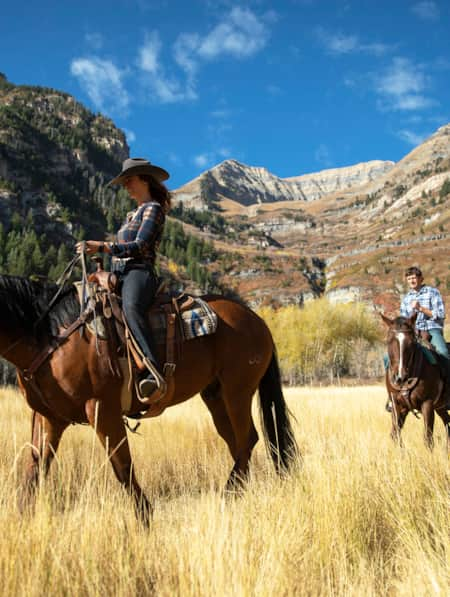
Filmed in Utah: 7 Itineraries Through Hollywood's Most Iconic Settings
Whether hitting the Sundance Film Festival in Park City and Salt Lake City in January or visiting Utah throughout the year, you’ll find yourself near some Utah’s most iconic and most filmed places.
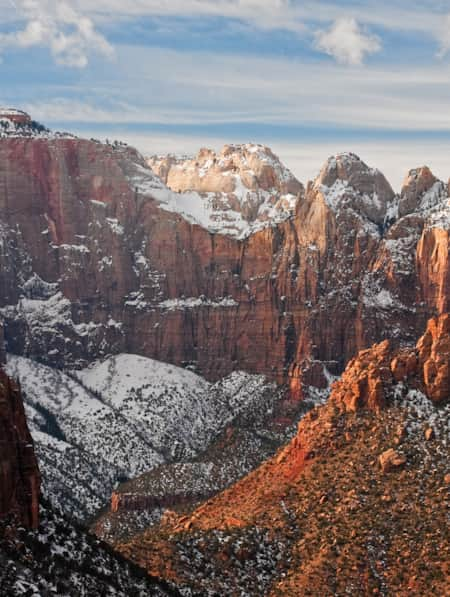
Winter Wonders in Greater Zion
As you’re mapping out your winter trip through southeastern Utah, consider adding the following parks and natural wonders to your itinerary.
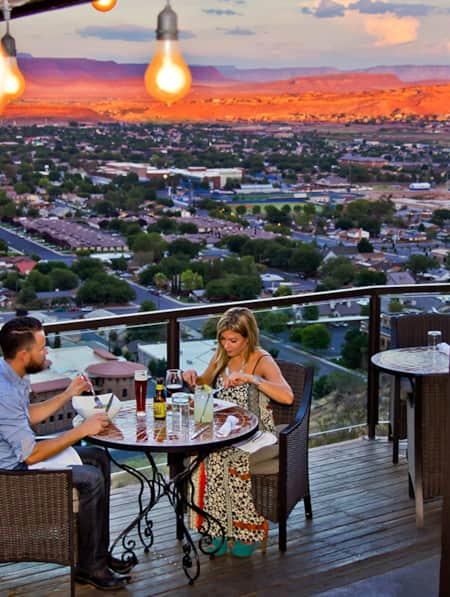
St. George Scene: Cliffside and The Bear Paw
Explore the best restaurants in St. George including Cliffside and The Bear Paw.
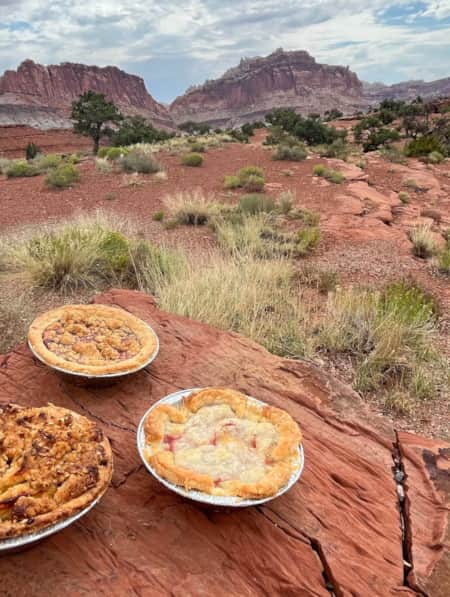
Utah’s Pie-Ala-Road: A Sweeter Way to Explore the State
Follow the Utah Pie Trail through a scenic landscape of water-sculpted canyons and sandstone peaks and past three iconic national parks to savor the flavor at five delectable pie stops.
Well-prepared travel is responsible travel.
Do your part by planning ahead

Your browser is not supported for this experience. We recommend using Chrome, Firefox, Edge, or Safari.
E-News Sign Up
Visitor guide.
© 2024 Visit San Antonio. All Rights Reserved.
- Today's news
- Reviews and deals
- Climate change
- 2024 election
- Newsletters
- Fall allergies
- Health news
- Mental health
- Sexual health
- Family health
- So mini ways
- Unapologetically
- Buying guides
- Labor Day sales
Entertainment
- How to Watch
- My watchlist
- Stock market
- Biden economy
- Personal finance
- Stocks: most active
- Stocks: gainers
- Stocks: losers
- Trending tickers
- World indices
- US Treasury bonds
- Top mutual funds
- Highest open interest
- Highest implied volatility
- Currency converter
- Basic materials
- Communication services
- Consumer cyclical
- Consumer defensive
- Financial services
- Industrials
- Real estate
- Mutual funds
- Credit cards
- Balance transfer cards
- Cash back cards
- Rewards cards
- Travel cards
- Online checking
- High-yield savings
- Money market
- Home equity loan
- Personal loans
- Student loans
- Options pit
- Fantasy football
- Pro Pick 'Em
- College Pick 'Em
- Fantasy baseball
- Fantasy hockey
- Fantasy basketball
- Download the app
- Daily fantasy
- Scores and schedules
- GameChannel
- World Baseball Classic
- Premier League
- CONCACAF League
- Champions League
- Motorsports
- Horse racing
New on Yahoo
- Privacy Dashboard
Olde Mistick Village show lets visitors get up close, personal with artworks, artists
Sep. 1—MYSTIC — Ann Torey said she was happy that visitors to her booth at Sunday's Olde Mistick Village Art Show could relate to her three-dimensional art, which is made from crushed eggshells and acrylic paint.
"They love it. Because there's so many people with chickens," Torey said. "So they look at this, and it's inspiring people. 'I'm going to do that with the kids tonight!' You know?"
Torey, 75, of Worcester, Mass., was one of at least 40 artists who showcased their individual styles Sunday at the annual event.
Torey, a longtime artist, explained the origins of her newest style ― eggshell art.
She explained that prior to the COVID-19 pandemic, she had spent 25 years primarily making glass wind chimes. But when she developed asthma, she could no longer cut and drill the stained glass pieces needed to make them, because it created glass dust that was bad for her lungs.
"In the meantime, I started saving eggshells ― for no particular reason. I'd wash them and put them back in their container and just stack them in my workshop," she said. "I was making eggs one day and I cracked it and I looked at it and I said, wow, that looks like a tulip. So from that day one, I washed them out, put them in their container, and saved them. You know, I don't know why I think the way I think."
Once the pandemic began and provided an abundance of time and no more obligation to sell at art shows, Torey said that's when she decided it was time to put down stained glass for good and pick up dimensional painting with the eggshells.
Two years of pandemic time allowed her to build up an inventory of eggshell paintings, she said.
"That was the end of my chimes, and I've been going forward with this. And it's quite successful, 'cause I'm the only one doing it," she said.
To make the paintings, Torey said she first paints the background, then puts some pencilmarks in the area she wants to paint and then, using acrylic paint and the eggshells, which can be crushed up or left in big pieces, begins to build what she sees in her mind. Eggshells are thin, she said, so they often have to be layered. If you take the eggshell and crush it and squeeze it, as Torey did for many of the pieces, it reduces down to about the size of a quarter, she said.
The paintings range in subject matter from mostly flowers, to landscapes and buildings, to marine life, and require different amounts of eggshells. A large painting of a lobster, with pieces of shell delicately arranged into the shape of the crustacean, took about three dozen eggs, Torey said. Pricewise, her smaller pieces were about $30, while larger, more intricate ones, like a painting of an orchid in a bowl, was about $895.
Dave Vieira, who lives close to Boston, but was in Mystic on vacation with his family, came up to the booth and said he'd never seen eggshell art before.
"It's beautiful," he said.
Nearby, Nicole Kohut-Lynch, of Seymour, was oil painting a picture of a rock formation in Sedona, Ariz.
She said she was using it to demonstrate her process, how she begins with under painting, then sketches, then layers on oil paint. This was the case for most of the works that hung from the wall of her booth, which ranged from photographic realism, to more impressionist pieces.
"I like different styles," she said.
Kohut-Lynch went to let down the back wall of the tent to protect the her oil paintings from the rain. Back there, and in the front, her paintings' subject matter consisted mostly of landscapes and wildlife, much of it in Arizona, where her father lives.
Many of the works featured interesting-looking frames, like wood with holes in them. Kohut-Lynch explained that they were made by her father, out of Cholla and Saguaro cacti, and Joshua tree, a kind of Yucca plant.
"He just started making them about two years ago," she said, adding her father had large collections of the plants and needed something to do with them.
Her pieces ranged from $50 up to $2,400. The most expensive was an impressionist painting of the Grand Canyon.
The booth of artist Carrie Wagner, who runs Cranston, R.I.-based SepiaLepus Illustration, displayed whimsical, multi-colored illustrations, along with painstakingly detailed maps of states or cities that highlighted their unique landmarks and cultural touchstones. She said the maps require a lot of research, and involves her trying to look for unusual or unique things about those places.
The style of them she likened to the work of the old mapmakers who used to draw dragons or sea monsters in unexplored territories where they though they'd exist.
As she explained her work, a few people came up to purchase prints. She said the art show is nice for being able to show off her work to a lot of new faces.
Meanwhile, Arnab Chakvaborty, of Montville, N.J., said his family was visiting Mystic and came by the show to explore. Though he was not sure if they'd buy anything, he said the family had been wowed by the variety of artwork, both in their uses of color and subject matter.
Recommended Stories
Bang & olufsen debuts the $1,549 beoplay h100 headphones.
You'll really have to love Bang & Olufsen audio gear to invest in its latest flagship headphones.
10 bold fantasy predictions for 2024 NFL season | Yahoo Fantasy Forecast
Week 1 and the NFL season have arrived and we are so ready for it. Matt Harmon and Andy Behrens reveal our fall pod calendar with three new weekly shows and co-hosts. While the rest of this week's pods will focus on Week 1, consider this pod our final full season preview of the year. Harmon and Behrens share their five boldest fantasy predictions for the 2024 season.
US Open: No. 1 Jannik Sinner fends off Tommy Paul to reach latest Grand Slam quarterfinals
Jessica Pegula and Iga Swiatek both advanced to the quarterfinals on the women's side on Monday.
No. 10 Florida State drops to 0-2 with stunningly disastrous home loss to Boston College
Boston College ran for 268 yards.
Brewers' Willy Adames hits home run in 5th consecutive game, also his 13th 3-run shot of season
Willy Adames hit a home run in his fifth consecutive game and his 13th three-run homer of the season, putting him in some rare company.
BigEndian founders hope to use their deep chip experience to help establish India in semiconductors
India, despite being home to 20% of the world's chip designers, lacks a significant presence in the global semiconductor market. BigEndian Semiconductors aims to capitalize on this shift by kicking off development of surveillance chips for cameras. Founded in May, the Bengaluru-based fabless design startup is led by CEO Sunil Kumar, a former executive at ARM Broadcom, and Intel, and the rest of the founding team add experience at chipmakers like Broadcom and Cypress Semiconductors.
Shohei Ohtani steals 3 bases in Dodgers' 11–6 win over Diamondbacks, moving closer to 50-50 season
Shohei Ohtani moved closer to a historic 50-50 season for an MLB hitter, stealing three bases to give him 46 for the season. He has 44 home runs with 24 games left to play.
Today's best sales: A Lenovo laptop for $219, Apple AirPods for $89 and more
Other Labor Day deals include a Cosori Air Fryer for just $90 and a No. 1 bestselling electric Rubbermaid scrubber for $19.
False-positive mammograms discourage women from breast cancer screening, study finds. Why it happens — and what to do.
Some women don't return for screenings after getting a false positive mammogram result, a new study shows.
Naoya Inoue vs. TJ Doheny: How to watch, full fight card, and more
Here's what to know and how to watch Naoya Inoue and TJ Doheny's fight this week.
- Weather Guides For Every Country In The World
- Algeria: Two Week Journey
- Cairo Travel Guide
- Best Time to Visit Lesotho
- Burkina Faso
- Central African Republic
- Côte d’Ivoire (Ivory Coast)
- Democratic Republic of the Congo
- Equatorial Guinea
- Guinea-Bissau
- Best Time to Visit
- Entry Rules and Visa requirements
- Salt Cathedral of Zipaquirá
- Dominican Republic
- Antigua and Barbuda
- El Salvador
- Afghanistan
- Bahrain Travel Guide
- The Cook Islands
- Aktau, Kazakhstan: Travel Guide and Tips
- Roadtrip in Western Kyrgyzstan
- Journey around Issyk-Kul
- Pakistan travel guide
- Albania Road Trip Guide
- Albania’s Entry Rules
- Yerevan Travel Guide
- Faroe Islands
- Suburbs of Paris
- Batumi Travel Guide
- Tbilisi Raves
- From Mestia to Ushguli (Svaneti) Trekking Route
- Transadjarian Highway
- Peloponesse Road Trip Guide
- Milan Travel Guide
- The Ultimate Venice Guide
- Modern Milanese architecture
- Budva Travel Guide: Montenegro’s main resort
- Montenegro Road Trip Guide
- Transylvania
- Yakutsk Travel Guide
- Journeying Through History: The BAM Railway Experience
- Veliky Ustyug Travel Guide: Meet the Ded Moroz
- Belgrade’s Cultural Guide
- Belgrade Off the Beaten Path
- Road Trip Guide
- Istanbul 🇹🇷: Hand-Painted Signs from a Century Ago
- From Grodno to Brest: a roadtrip
- Bosnia and Herzegovina
- Holy See (Vatican)
- Liechtenstein
Sakhalin: Your Essential Guide to Russia’s Enigmatic Eastern Island
- January 14, 2024
A Journey Through Giant Burdocks, Wild Bears, and the Echoes of Ancient Japanese Temples
From the most dreaded place of exile in the Russian Empire to a Japanese industrial base and one of the most attractive and inaccessible places for domestic tourism in Russia.
Table of Contents
An island that was Russian, then Japanese, and then Russian again
From the 17th to the mid-19th century, it was believed that Sakhalin was a peninsula. This misconception firmly established itself on the maps of the time, as navigators failed to circumnavigate the island. The proximity of Sakhalin’s southern tip to the mainland created a false impression of being impassable for ships. An additional complexity arose from the fact that the route taken by ships from the Russian Empire involved passing through a narrow strait, which Nevelskoy managed to navigate only in 1849.
For a long time, people did not believe Nevelskoy, but he insisted that he had discovered a route through the strait, for which he became something of a hero in Primorye. Monuments and plaques dedicated to him can be found in Yuzhno-Sakhalinsk, Vladivostok, and Khabarovsk. The H4H creative association created a graphic novel based on this story, which won a cultural initiatives contest and became part of the interior of the Khabarovsk Airport. By the way, the Sakhalin region is the only Russian entity entirely located on islands.

The remote and isolated location of the island during the Russian Empire was used as a natural barrier, and it became the site of penal colonies for hard labor prisoners. Its geographical position led to Sakhalin’s hard labor being regarded as particularly cruel.
During the period of the island’s development, Russian ships followed the Amur River and reached the island from the north, where the oldest port, Alexandrovsk, was founded. The Japanese attempted to develop the island from the south, entering through the Kuril Islands (part of the Sakhalin region) and Aniva Bay. For a long time, the Kurils were inhabited by the Ainu, representatives of a small indigenous people. The very word “Kurils” comes from the Ainu: “kuru” means “man.”
In the 17th century, Japan conducted its first expeditions towards the islands and began their development. Russia reached them later. The first mentions of the islands in Russian language date back to the late 17th century. For a long time, Russian, Dutch, Japanese, and Anglo-French navigators studied the islands, landed on them, and disputed their territorial ownership. However, only Russia and Japan managed to establish a foothold. To end the territorial disputes, the governments of the two countries signed an agreement under which the Kuril Islands went to Japan, and Sakhalin to Russia, which continued to develop the island mainly from the north. After the Russo-Japanese War of 1904-1905, which ended in Russia’s defeat, the southern part of Sakhalin became part of Japan as the Karafuto Prefecture.

Until the second half of the 20th century, the island was owned by Japan and was quite successful in developing its resources. A huge number of mines were opened, several cities and lighthouses were built. In particular, the current regional center, Yuzhno-Sakhalinsk, was the former Japanese city of Toyohara. The famous Aniva lighthouse, now considered a symbol of Sakhalin, was built by Japanese engineers. After Japan’s defeat in World War II, the island passed to the Soviet Union. Contrary to history, the main life of the island moved from the north to the south. Alexandrovsk, which was convenient to reach by water, lost to Yuzhno-Sakhalinsk with its infrastructure built by the Japanese, connections to neighboring cities, and airport. Interestingly, before leaving, the Japanese buried and hid the mining sites, and locals say that not all the old mines have been found yet, and they are sometimes stumbled upon during walks.
Because the island belonged to three different countries in just over a hundred years, it did not have time to develop any significant urban infrastructure. The cities lack outstanding architectural monuments and unique museums. However, some unusual Japanese architecture has remained. Meanwhile, Sakhalin compactly houses incredible natural attractions. Here, one can climb through forests and bamboo thickets to breathtakingly beautiful mountains as if outlined in graphite, and through a mountain pass reach the sea, into which clear mountain rivers flow with fish splashing in them.

The Ainu and Nivkh: Inhabitants of Sakhalin
For a long time, the island was mainly inhabited by the Ainu and Nivkh peoples. These ethnic groups are very different, making their coexistence as unusual as the neighboring of birch and bamboo on the slopes of Sakhalin’s mountains. Both are isolate peoples . However, the Ainu belong to the Australoid race, while the Nivkh are Mongoloids (the main population of Asian territories). It’s fascinating how representatives of different races have coexisted for ages on a small piece of land at the edge of the world.
There is no single version regarding the origin of the Ainu, leading to a multitude of theories — both scientific and conspiratorial. One theory suggests that the Ainu are the ancestors of the indigenous population of Australia, remaining in the north after continental migration. Some researchers write that the Ainu are the forebears of the Japanese. This theory is supported by the fact that before Japanese expansion, the Ainu mainly inhabited the Japanese island of Hokkaido. However, the Ainu suffered greatly from Japanese imperialism, and their culture and language were almost completely destroyed in the 19th and early 20th centuries. Now, there are just over two thousand Ainu living on Sakhalin.

The Nivkh are among the indigenous small-numbered peoples of the north. They suffered less from Japanese rule. However, during the Soviet era, they experienced a difficult phase of literacy development, destruction of tribal communities, and relocation to cities. About 2,200 Nivkh live in the Sakhalin region and another approximately two thousand in Khabarovsk.

During the Karafuto period, Japan brought captured Koreans to Sakhalin for hard labor. By the mid-20th century, the Korean population of the island was about 45,000 people. For comparison, the current population of Yuzhno-Sakhalinsk is 180,000. This large number of people, deprived of their homeland, was forced to adapt to life first under Japanese and then Soviet rule. In the USSR, Koreans were issued passports, and there were national kindergartens and schools. However, Sakhalin Koreans did not feel part of the larger community of Soviet Koreans (Koryo-saram) and struggled to integrate. Moreover, they were considered members of an ‘unreliable nation’ because they had lived in the Japanese Empire.

In the late 1990s, three countries – Russia, South Korea, and Japan – began a repatriation campaign for the first generation of Sakhalin Koreans (born before August 15, 1945) to their historical homeland. Now, about 3,500 repatriates from Russia live in South Korea. Under the program, the Korean government provides medical insurance and a monthly allowance to the repatriates. The Japanese government, in turn, buys housing (apartments up to 40 m²) and covers transportation costs. Additionally, every two years, Sakhalin Koreans who have moved to their homeland have the right to visit Sakhalin for free, funded by the Japanese government. Most Sakhalin Koreans settled in the city of Ansan , where 500 apartments were specially built for them.
Korean influence is weakly traced on Sakhalin: many Sakhalin Koreans no longer know the language and do not associate themselves with Korea. However, there are several authentic restaurants (for example, “Koba” ) on the island where you can try traditional dishes.
Yuzhno-Sakhalinsk — the capital and base for exploring the island
The city is predominantly characterized by typical Soviet architecture, with almost no remaining Japanese buildings. This is because during the Soviet period, the city was radically rebuilt after being liberated from ‘imperialist Japanese rule.’ Many buildings were demolished, and from the few that remained, some were turned into museums. Perhaps the main thing that has been preserved from the Japanese period is the layout. The city was founded from scratch near the Russian village of Vladimirovka, and Chicago was chosen as the model for its layout. Toyohara was divided into four parts by two main streets, O-dori (now Lenin) and Maoka-dori (Sakhalinskaya).

Japan established itself thoroughly on the island. In Toyohara, trade routes converged, new bays were developed, and roads were built. The city’s population grew steadily. Initially due to the military garrison, and later due to a paper mill, a sugar and distillery plant. Now, the buildings of the former Japanese factories are abandoned. Many of them can only be accessed with rare tours, while others are completely closed. However, their presence is still recalled by street names, such as Paper Street.

Another building in the Neo-Japanese style is the Karafuto Governorate Museum built in the 1930s (29 Communist Avenue). It now houses the Sakhalin Regional Museum . And in the former bank of colonial development, there is the Art Museum (137 Lenin Street).

Several other iconic buildings constructed by the Japanese have been preserved: the central hospital of Toyohara (41 Chekhov Street), the conference hall of the Karafuto Governorate (30 Dzerzhinsky Street), and the Toyohara City Hall (41 Communist Avenue). The Sakhalin Railway Museum in Yuzhno-Sakhalinsk is distinct from many similar museums in Russia due to its exhibits. This is because the island long maintained the Japanese standard of railway gauge, which differs from the Russian standard. Accordingly, the rolling stock was entirely different.
If in Vladivostok everything is named after the Far Eastern explorer and writer Vladimir Arsenyev, then in Yuzhno-Sakhalinsk, mentions of Chekhov are everywhere. At the end of the 19th century, Sakhalin was both the most dreaded place for exile to hard labor and one of the most tempting corners of Russia, which was not so easy to access. Chekhov received an editorial assignment and embarked on a ship along with prisoners, military personnel, and sailors to the most remote point of the empire. In his notes, which Chekhov compiled under the title ‘The Island of Sakhalin,’ the writer talked about many things: the geography and climate of the island, the life of the convicts, and ordinary residents. This book caused a great resonance at the time, and even now it was very interesting to read it while traveling to Sakhalin: some things have changed drastically, while others have remained the same. Now in Yuzhno-Sakhalinsk, there is even a museum dedicated to this one book, which turned out to be so significant for the island.
GoSakhalin is the website of the Sakhalin Tourist and Information Center. And in their official Telegram channel , you can find announcements of affordable excursions shortly before they start.
In any case, for travelers, Yuzhno-Sakhalinsk remains primarily a hub and a place of rest. Here they return for the night and dinner, and it seems that real adventures begin outside the doorstep.
Surrounding Area
10–20 kilometers from Yuzhno-Sakhalinsk
The main reason people visit Sakhalin is for its unique nature. Mountains, forests, rivers, lakes, and the sea, all on a small piece of land. In one day, you can travel from the Sea of Okhotsk to the Sea of Japan, cross several climate zones, see bamboo groves, birches, and spruces in one place, spot a running fox and a swimming orca. The island’s landscapes can boldly compete in Instagram appeal with Iceland or Norway.
Within Yuzhno-Sakhalinsk alone, there are about 30 kilometers of marked ecotrails, with brief descriptions and routes available on the official tourism portal. I also found an ecotrail in Nevelsk, which is not mentioned on the official website.
The ecotrails in Yuzhno-Sakhalinsk start from the ‘Mountain Air’ ski center on the sopka (a term for mountains in the Far East) Bolshevik. There are five in total: ‘Children’s’ (2.7 kilometers), ‘Eight’ (8 kilometers), ‘Northern Ring’ (9 kilometers), ‘Russian’ (3.2 kilometers), and ‘Yelanka’ (5 kilometers). You can take a cable car to the start of the trails and then slowly descend through the forest and park to the city. However, the lift does not operate in rainy and windy weather.

Hiking the ‘Eight’ trail took me no more than three hours, including stops to catch my breath and take photos. Every kilometer and a half along the route, there are benches. From the top of the mountain, there is a view of Yuzhno-Sakhalinsk, and it seems you can see a piece of the Sea of Okhotsk.

Chekhov Peak
The route to Chekhov Peak is a high-mountain trekking path that requires a certain level of physical fitness. Chekhov Peak has an elevation of 1045 meters, with an absolute altitude gain of 752 meters. The trail is narrow and slippery in places, hardly suitable for children or people with limited mobility.

Chekhov Peak is part of the Susunai Range, which supports Yuzhno-Sakhalinsk from the southeast. You can exit from Gagarin city park to the foothills in about half an hour. The ascent to the peak itself cannot be missed: a marked trail and informational signs lead to it. On particularly steep ascents, ropes are hung for safety, but it is possible to walk up the slope without them.
In late spring, the forest trail has many streams, as well as May primroses and butterflies. The foothills are scattered with rare, incredibly large, and wonderfully fragrant marsh callas. Halfway to the peak, bamboo thickets are encountered, through which birches break through. This is also a kind of magic because, as a biologist friend explained to me, birch and bamboo are not supposed to coexist in the natural environment, but somehow they manage to do so. Occasionally, spruces are encountered — not tall, but very fluffy. Closer to the top, the vegetation becomes sparser, and the impressive views of the sea, mountains, and lakes open up from the height.

- The entire hike takes five to six hours.
- Even in summer, there is snow on the summit. In the afternoon, it starts to melt, making it more difficult to walk.
- Don’t forget to bring food and water.
- Wear boots with covered ankles, a jacket, and a head covering.
- Inform your family and friends, and someone living in Sakhalin, before setting out on the route. If you’re traveling alone, you could notify, for example, the hotel receptionist or roommates in a hostel.
- Snakes and bears are found around the trail. Watch your feet and try to make as much noise as possible. For example, play music on your phone and sing along occasionally.
- The ascent to Chekhov Peak can be the start of a journey to the village of Lesnoye on the shore of the Sea of Okhotsk. The distance to the village is 27 kilometers. With good preparation and an early start from Yuzhno-Sakhalinsk, this distance can be covered in one day.

Mud Volcano in Klyuchi
A mud volcano is an eruption on the earth’s surface of clay masses, mineralized waters, and gases. The mechanism of formation of these volcanoes is not fully understood. According to the existing theory, such volcanoes are formed near oil fields.
The mud volcano in Klyuchi consists of a mud field about 200 meters in diameter. There, you can see about 20 points of activity, resembling miniature volcano craters. This mud volcano became active in 1959, 1979, 2001, and 2011 (the last time due to a strong earthquake in Japan). During these eruptions, mud columns reached several tens of meters in height. Bus 189 goes to Klyuchi from Yuzhno-Sakhalinsk. The distance from the village to the top of the volcano is nine kilometers and takes about two and a half hours to walk.

Ecopark in the Vestochka area: Frog Rock, Aikhor Waterfall, ‘Sunny Glade’ Recreation Park
Not far from Yuzhno-Sakhalinsk, there is a fairly large ecopark, known primarily for the Frog Rock outcrop. An outcrop is a remnant of harder rock around which softer rock has eroded over time. Outcrops are often known for their unusual shapes and are natural monuments. Frog Rock is part of a series of rocks standing one behind the other. This was once the seabed of an ancient sea, and fossilized shells can be found in its vicinity. From the top of the rock, amazing views of the Aniva Bay, Tunaycha and Changeable Lakes open up. This place was sacred to the Ainu, the indigenous inhabitants of the island.

The trail to the ‘Sunny Glade’ ecopark begins behind the ‘Electron’ culture house. Despite its name, it is not a city park, but a full-fledged forest with laid-out paths. There are houses, glades with tables for rest where you can cook barbecues, and wooden walkways leading to various attractions. These are all paid services.

The path to Frog Rock outcrop goes along the Komissarovka River. In areas of spring flooding, callas bloom and bamboo grows. The outcrop is located on a hill, with a total elevation gain of about 300 meters. The road is quite challenging, usually taking from an hour to an hour and a half. The higher you climb, the more you can see: the sea, the mountain gorge, the road to Vestochka. In the same park is the Aikhor Waterfall, which is also a short climb away, but along a less well-maintained trail. You can plan a whole day to visit Vestochka and even spend the night, without returning to Yuzhno-Sakhalinsk.

Vestochka is three high-rise buildings on one side of the road and a cottage settlement on the other. It is part of Yuzhno-Sakhalinsk, though located 15 kilometers from the main part of the city. A taxi there costs about 1000 rubles and takes 40 minutes. About a kilometer after turning off the main road, the asphalt ends and a terribly dusty dirt road begins. If you’re lucky, you can catch a bus that runs three times a day.
What else to see on the island
40 kilometers from Yuzhno-Sakhalinsk
The oldest city in the south of Sakhalin, founded by Nevelskoy’s expedition. Here you can find a huge number of monuments dedicated to sailors, naval battles, and ships. The most significant monument in the city in recent decades has become the stele dedicated to ‘Koreans interned by the Japanese in Sakhalin, who never returned to their homeland,’ located on Mount Sorrow, created through the efforts of three countries’ governments (Russia, Japan, and Korea).

In Korsakov, some Japanese heritage has been preserved: the former building of the Hokkaido Takushoku Bank, a colonial development bank (Sovetskaya Street, 3), trade warehouses in the port, a document storage facility ‘Bunsyoko’ (Krasnoflotskaya Street, 1), a couple of rusty fire hydrants, and remnants of Shinto temples in the form of pillars with hieroglyphs. One of the local nighttime entertainments is watching the lights of the gas processing plant.
How to get there. Three electric trains a day, the journey takes just over an hour, and the ticket costs 75 rubles (0.75 euros).

Bird and Giant Capes
90 kilometers from Yuzhno-Sakhalinsk
Two capes, recognized as natural monuments in 1990, along whose coasts are many wind and wave-carved grottoes, caves, arches, and columns of various sizes and whimsical shapes, among which colonies of sea birds reside.
The place is not very close, but it’s very picturesque at any time of the year. In the area of one of the rocks, there is a pool where, during the salmon spawning period, you can observe a fascinating spectacle — a huge gathering of pink salmon.
Many tourists stay on the coast overnight to witness the sunset and sunrise. Near Cape Giant, there is a toilet, parking, and a rest area with benches.
How to get there. The journey from Yuzhno-Sakhalinsk goes through the village of Okhotskoe, where you can buy fresh crabs, and takes about three hours one way. The road is fully passable only by high vehicles like Mitsubishi Pajero, Suzuki Jimny, as the last ten kilometers of the route have deep puddles, potholes, small cliffs, and rivers.

Nevelsk and Steller Sea Lions
Nevelsk is nestled between mountains and sea. The rocky mountains and the coast, which consists of small stone needles and shells, in every way explain why Chekhov so often mentioned in ‘The Island of Sakhalin’ how harsh the land of Sakhalin is.

Steller sea lions are the largest of the eared seals. One of their habitats is the breakwater in Nevelsk. As soon as you arrive in the town, the smell from the Steller sea lions’ haul-out site hits you. ‘They eat there, live, give birth to their young – that’s why it smells,’ the locals explain. Another feature is the noise. Steller sea lions are very loud!
You can view the sea lions from the central square, where binoculars are installed. However, tourists usually hire a boat and approach the haul-out site to get a closer look at the seals. You can see how the Steller sea lions bark, lie in the sun, jump into the sea and, most interestingly, try to jump back. The views from the square through binoculars are not as detailed and impressive. A place on the boat will cost 1000–1500 rubles (10.05 – (15.07 euros). You can also buy a tour from Yuzhno-Sakhalinsk for 3500 rubles (35.16 euros). The most animals are present in spring and early summer. In autumn, there may be a couple of dozen individuals left.

From the embankment, you can observe the huge kelp laminaria floating in the sea. Some travelers catch them themselves and eat them. Although dishes made from seaweed are found in cafes and also sold in stores. Signs are installed on the shore indicating where to run in case of a tsunami. The last major earthquake with waves was recorded in 2007. Many houses were destroyed and two people died. The most famous Sakhalin tsunami was the 1952 tragedy , when the aftermath of the earthquake almost completely destroyed Severo-Kurilsk.
How to get there. From the bus station (Karl Marx Street, 51b) in Yuzhno-Sakhalinsk, buses go to Nevelsk, the ticket costs 300 rubles (3.01 euros), and the journey takes about an hour. Tickets can be purchased at the bus station ticket office or from the driver (cash or transfer). It’s not possible to board the bus somewhere in the city, as the bus does not make stops. It’s better to buy a return ticket immediately upon arrival in Nevelsk at the Nevelsk bus station ticket office (Lenina Street, 1). The bus is popular with locals, and there may simply be no seats left.
Remnants of structures from the Karafuto period include the Maoka-Jinja temple with a Japanese-style garden and an abandoned railway built by the Japanese. It used to connect Kholmsk with Yuzhno-Sakhalinsk. Tourists usually come to see two photogenic bridges – Devil’s and Witch’s – and a tunnel in the mountain that makes a full circle inside it. The trail passes along the old rails, and there are many vipers, so one needs to watch their step.
How to get there. The bus to Kholmsk takes two hours, the ticket costs 450 rubles (4.52 euros), with 14 trips a day.

Slepikovsky Cape and Lighthouse
120 kilometers from Yuzhno-Sakhalinsk
At Slepikovsky Cape, there is the only relic grove of Korean cedar on Sakhalin. Also located here is the functioning Slepikovsky Lighthouse, which is a 27-meter tall round tower, connected by corridors to utility and residential buildings.

The cape and lighthouse are named after the commander of the Russian partisan detachment Bronislav Grotto-Slepikovsky, who operated in Southern Sakhalin during the 1904–1905 war. The route to the lighthouse goes through the villages of Yablochnoe and Sadovniki, where some of the best beaches on Sakhalin are located — with the cleanest water and white sand.
How to get there. The cape is located 29 kilometers north of Kholmsk. From Kholmsk to the turn towards the lighthouse, there is asphalt with dirt sections. From the turn to the lighthouse, there is first a dirt road, then beach sand, which is recommended to be driven on with deflated tires. Visiting time is from spring to autumn, as the road to the cape is not cleared in winter.
110 kilometers from Yuzhno-Sakhalinsk
In 1891, when the island had a penal colony, this was the Russian village of Siraroko, named after a nearby Ainu settlement. In 1905, the south of Sakhalin was given to the Japanese, and the village was renamed Higashi Shiraura. Here there were a railway station, a brick factory, and a coal mine. 40 years later, the settlement was renamed Vzmorye.
During the Japanese times, there was the Shinto shrine Higashi Shiraura Inari-Jinja. Only the torii gates remain — P-shaped gates without doors that are placed on the path to a Shinto shrine. These are the only torii on Sakhalin. On the torii, there is an inscription ‘In honor of the 2600th anniversary of the foundation of Great Japan’ — this mythological date was widely celebrated in 1940.

On the way to the torii, you can see the famous giant burdocks and bear’s garlic. Vzmorye is also known as a place where poached crabs are sold along the highway.
How to get there. Two electric trains and one train that start from Yuzhno-Sakhalinsk stop in Vzmorye. Unfortunately, all three are in the evening. You can also get there on passing buses that go to the north of the island.
Tikhaya Bay
140 kilometers from Yuzhno-Sakhalinsk
On one side, the bay is framed by Mount Smely, and on the other side, the majestic Zhdanko Ridge begins. To the left in the bay itself is an island-kekur, which can be reached during low tide, as well as the epic cliffs of Tikhaya Cape. By the way, behind this cape, there are waterfalls that become icefalls in winter. At the base of the bay is the mouth of the Tikhaya River, where during the season you can see the spawning of pink salmon and chum salmon. Bears are aware of this, so they are often encountered here.
How to get there. Buses going to Poronaysk stop in the village of Tikhoye, near which the bay is located. There are four trips a day.

Aniva Lighthouse

The lighthouse has a complex history: there were attempts to maintain it under Soviet rule, but Aniva was so remote from inhabited areas that it was not profitable. Eventually, the lighthouse was switched to autonomous mode, bringing in a radioactive isotope to sustain its operation, and then it was completely closed. To this day, you can find signs on the walls reading ‘Caution, radioactive’. But now this warning is outdated, as the radioactive isotope was removed when the lighthouse was decommissioned. The lighthouse is very beautiful, offering views of the island and sea, and inside you can explore the remnants of rooms and working areas.

On the return trip, tourists are also taken to Mramornaya Bay, where you can also climb a mountain and view the jagged coast of Sakhalin from above. Orcas and whales are often encountered in these areas, most frequently in summer. I would also recommend taking a combined tour in summer to Aniva Lighthouse, the Blue Lakes, and Busse Lagoon, where you can see the amazingly blue waters and try sea urchins.

A kilometer from Novikov is Cape Tri Kamnya (46.320342 143.373006), which can even be reached by car. Four kilometers from the cape is the small Strelka waterfall , which requires a walk. If you stay in the village overnight, you can take a hike to the Blue (turquoise) Lakes (46.359603, 143.471909). On the way, there’s an abandoned Japanese power station. You can extend your route by another 15 kilometers and reach the opposite shore of the peninsula – to Cape Evstafiya. The road from Novikov to Cape Evstafyeva through the Blue Lakes can be driven in a jeep, if there hasn’t been prolonged rain before. But it’s better to ask in advance those who have recently been there, and get the phone number of a local tractor driver in Novikov, so that if something happens, he can pull you out.

How to get there. Getting there independently is almost impossible. The lighthouse is located on a rocky outcrop in the sea, and the nearest land is a high cliff. However, some people do reach Novikovo (the nearest village) by bus or car, and then walk 44 kilometers on foot to Aniva (the name of both the lighthouse and the bay). It takes about one and a half hours to drive from Yuzhno-Sakhalinsk to Novikovo. And then another two hours of rough dirt road to the boat dock. A tour from the company ‘Friends-Hikers’ costs 6000 rubles (60.28 euros) in May (in summer – 7000 rubles (70.33 euros)).
Klokovsky Waterfall
190 kilometers from Yuzhno-Sakhalinsk
Klokovsky Waterfall is one of the highest waterfalls on Sakhalin Island. Its height is variously reported to be 48–49 meters, with a width of up to nine meters. The waterfall is accessible year-round, but is most full in late spring and early summer.

Alexandrovsk-Sakhalinsky

The ‘Tri Brata’ (Three Brothers) rocks are definitely a symbol of Alexandrovsk-Sakhalinsky, and perhaps of the entire island. They are located in the Alexandrovsk Gulf almost opposite Cape Zhonkiyor. From the cape, there is a stunning view of the vast Tatar Strait and the Three Brothers. At low tide, it’s possible to calmly explore all the attractions of the gulf, collect seaweed and shells, see hermit crabs scuttling along the seabed with their shells on their backs, or watch the leaves of laminaria sway. At the strongest low tide, you can even walk to the Three Brothers through the water.

In the 19th century, convicts carved a 90-meter tunnel through Cape Zhonkiyor to service the lighthouse. To reach the tunnel by land, you need to come at low tide. Otherwise, you’ll have to climb the rocks. The tunnel is lined with logs, but there is almost always water at the bottom and a strong wind howls through it. If you pass through the tunnel, you will see the ‘Tri Sestry’ (Three Sisters) rocks and an old lighthouse from the end of the 19th century. All these places are described by Chekhov in ‘The Island of Sakhalin’: ‘Most often we went to the lighthouse, which stands high above the valley, on Cape Zhonkiyor. During the day, the lighthouse, if looked at from below, is a modest white house with a mast and lantern, but at night it shines brightly in the darkness, and then it seems that the penal colony looks at the world with its red eye. The road to the house climbs steeply, winding around the mountain, past old larches and firs. The higher you climb, the freer you breathe; the sea spreads before your eyes, thoughts gradually come, having nothing to do with the prison, the penal colony, or the exile settlement, and only then do you realize how dull and difficult life is down below.’
How to get there. From Yuzhno-Sakhalinsk, there is one bus trip per day – at 12:10. The ticket costs 2200 rubles (22.10 euros), and the journey takes nine hours.

600 kilometers from Yuzhno-Sakhalinsk
The main transit point on the way to the oil refineries. The village might be of interest to those curious to see a harsh northern town living off production: low-rise buildings made of siding and unexpectedly bright murals on the walls of five-story buildings. There is a local history museum in the village (Sovetskaya Street, 3) – it is praised for its excellent exhibition of the Nivkh culture and a monument to Nevelskoy. Also, one of the longest rivers of Sakhalin, the Tym (which translates from Nivkh as ‘spawning river’), flows through the town.
How to get there. A night train goes to Nogliki every day, taking almost 12 hours. The cheapest ticket in a seated carriage costs 1100 rubles (11.05 euros), a compartment – 4100 (41.19 euros). There is even a luxury (SV) carriage for 12600 rubles (126.59 euros).
Where to Stay
Hostels in the Far East are divided into work and tourist types. The former will also accommodate tourists, but the atmosphere there is like a dormitory where their own rules are already established, and you may feel like an uninvited guest. To avoid such a hostel, it’s important to carefully read the reviews, not book the cheapest hostels, not stay on the outskirts or near airports and train stations.
In the Islander hostel , mainly travelers stay, it’s very cozy, with convenient kitchen and showers with toilets. A double room costs 3000 rubles per day, and dorms – from 900 rubles (9.04 euros) per night. If you book directly through the website and for a long term, you can get a good discount.
The ‘Moneron’ hotel is located near the railway and bus stations. It’s a classic budget hotel with small clean rooms. The ‘comfort’ class rooms have a bath, and the hotel provides a complete set with slippers, towels, and a hairdryer. Prices start from 2800 rubles (28.13 euros) per night for a single economy room, while ‘comfort’ costs 4900 rubles (49.23 euros). Breakfast is included in the price.
The ‘Belka’ hotel building is made using Finnish technology in a wooden style from milled timber. The cost of large rooms with wooden walls and huge beds starts from 5800 rubles (58.27 euros). Breakfast is also included in the price. The hotel complex includes a sauna, spa, tavern, and gym.
Near Bussé Bay is the island’s only dome-shaped glamping site. A night for two costs 8000-10,000 rubles (80.37 – 100.47 euros). An extra bed is 2000 (20.09 euros). Each dome has a shower, toilet, and electricity. On cooler days, you can light the stove and sit by the fire with a cup of hot cocoa.

In other towns, apart from Yuzhno-Sakhalinsk, the choice of hotels is quite modest and usually limited to one or two hotels, which cannot always be booked online. They have to be found on the map and booked by phone.
Transport on the Island
Car. If you’re only traveling between cities, there won’t be any problems – the roads between them are mostly paved, and the dirt roads are of more or less good quality. It gets more complicated with natural attractions. Almost all of them are accessed by dirt roads, which not every car can navigate.
In Yuzhno-Sakhalinsk, ‘Yandex.Taxi’ and ‘Maxim’ operate (also in Korsakov and Kholmsk). A trip within the city limits will cost a maximum of 300 rubles (3.01 euros).

Railway. From Yuzhno-Sakhalinsk, about 30 electric trains depart daily. Most of them go to nearby areas like Dalnyaya, Khristoforovka, and Novoaleksandrovka stations – 8–23 minutes travel time.
To other cities, there’s only one electric train per day. It takes an hour to Korsakov and the ticket costs 80 rubles (0.80 euro). To Tomari, it’s four hours and 300 rubles (3.01 euros). To Poronaysk, it’s five hours of travel and 500 rubles (5.02 euros) for a ticket. Long-distance electric trains depart in the evening, as these routes are used by residents of the province who return from work in Yuzhno-Sakhalinsk to their homes.
There is also one train on the island – Yuzhno-Sakhalinsk to Nogliki, 12 hours of travel and 1100 rubles (11.05 euros) for a ticket in a sitting carriage.

Buses. It seems you can reach even the most remote settlements by bus. Often there’s only one trip per day, but at least it exists. To Kholmsk, Nevelsk, and Korsakov, the journey takes about an hour and a half, with tickets costing around 300 rubles (3.01 euros); to Poronaysk and Uglegorsk, it’s four to five hours and 1200 rubles (12.06 euros) for a ticket. You can check the current schedule on avtovokzaly.ru . But it’s always better to double-check by phone: +7 (4242) 72-25-53. The address of the bus station is Karl Marx Street, 51b.
Airplane. Sakhalin has a quite extensive network of airports, and you can fly from Yuzhno-Sakhalinsk to Okha, Zonalnoye, Shakhtyorsk, Poronaysk, Smirnykh, Yuzhno-Kurilsk, and Iturup. Flights are operated by the Far Eastern airlines ‘Aurora’ and ‘Taiga’ . These routes are served by small propeller planes Bombardier and Mi-8 helicopters. Such a flight is an interesting experience in itself. Moreover, some flights are quite inexpensive. For example, to Zonalnoye, Shakhtyorsk, and Poronaysk, tickets cost 2000–3000 rubles (20.09 – 30.14 euros) one way. To Okha and the Kurils – from 6000 rubles (60.28 euros).
Ferry. From Korsakov, ferries run to different settlements in the Kurils every three to four days. The ferry to Kurilsk takes about 22 hours, to Yuzhno-Kurilsk – 22–30 hours, and to Malokurilskoye – about 40 hours. Interestingly, a ticket to any of these settlements costs from 2800 rubles (28.13 euros), available on the website of the ferry company.
How to get there
By plain. To travel to Yuzhno-Sakhalinsk from Europe, passengers typically fly through major transit hubs. Common routes involve flying from a European city to one of the major Russian airports offering direct flights to Yuzhno-Sakhalinsk, such as Moscow’s Sheremetyevo or Domodedovo airports. In 2023 it is only possible to fly to Moscow from major transit hubs such as Istanbul or Erevan. From there, travelers can catch one of the direct flights to the island. Some routes might also include stops or transfers in other large cities in Russia or Asia, depending on the airline and the flight itinerary, for instance, Novosibirsk, Krasnoyarsk, Irkutsk, Ulan-Ude, Chita, Blagoveshchensk, Vladivostok, Khabarovsk, Komsomolsk-on-Amur, Sovetskaya Gavan, and Petropavlovsk-Kamchatsky. There is even one international flight from Harbin, China.
In good weather, on approach to Yuzhno-Sakhalinsk, you can see the Tatar Strait, the Western Ridge, and the city itself. The airport is located within the city limits, and from there, you can easily reach any point by public transport (buses 63 and 3) or taxi.

Ferry. Vanino (Khabarovsk Krai) to Kholmsk (Sakhalin) . Passenger tickets for the ferry are sold at the Vanino railway station or at the ticket office in Kholmsk (Lenin Square, 5). They can also be reserved by phone: +7 (42137) 74088 (Vanino), +7 (42433) 50880 (Kholmsk). The ferries run daily, with a journey time of 18–20 hours. A seat costs 650 rubles (6.53 euros), while the cheapest cabin spot is 1400 rubles (14.07 euros). There is a dining room on board.
I was on the island in early May, and this has its pros and cons. On one hand, it’s already not very cold in Sakhalin at this time, and you can walk around in a light jacket or sweatshirt, and sometimes even just in a T-shirt. At the end of spring, you can catch the largest number of Steller sea lions in Nevelsk (closer to summer they migrate towards Avacha Bay). Also at this time, you can see the forest awakening: streams penetrate it from all sides, in their floodplains swamp callas bloom, meadows fill with primroses, and the hills are covered with bright green bamboo shoots. On the other hand, there is still snow in the mountains, in which you can get stuck while climbing, and the sea, which is not very warm in these areas, is completely unsuitable for swimming.
In summer, Sakhalin is not very hot, the coast blooms with wild roses, the sea warms up a bit, and there is less chance of bad weather when visiting remote attractions. Also, it’s precisely at this time you can see orcas (June – July) and whales (July – August), as well as the salmon spawning.
In winter, snowboarders and skiers come to Sakhalin. The mountains on the island are not high, so they are suitable even for beginners.

Related posts:
- The Vertical Grain Elevator (Silo) in Samara — A Benchmark of Brutalist Architecture
- Kamchatka: “Island” of Volcanoes, Bears, and Red Caviar
- Yekaterinburg: A Comprehensive Guide to the Ever-Young and Protest-Ridden City
- Altai Republic (Russia) Travel Guide: A Journey through Twisting Mountain Roads
Leave a Reply Cancel reply
Your email address will not be published. Required fields are marked *
Save my name, email, and website in this browser for the next time I comment.

Sakhalin, Russia
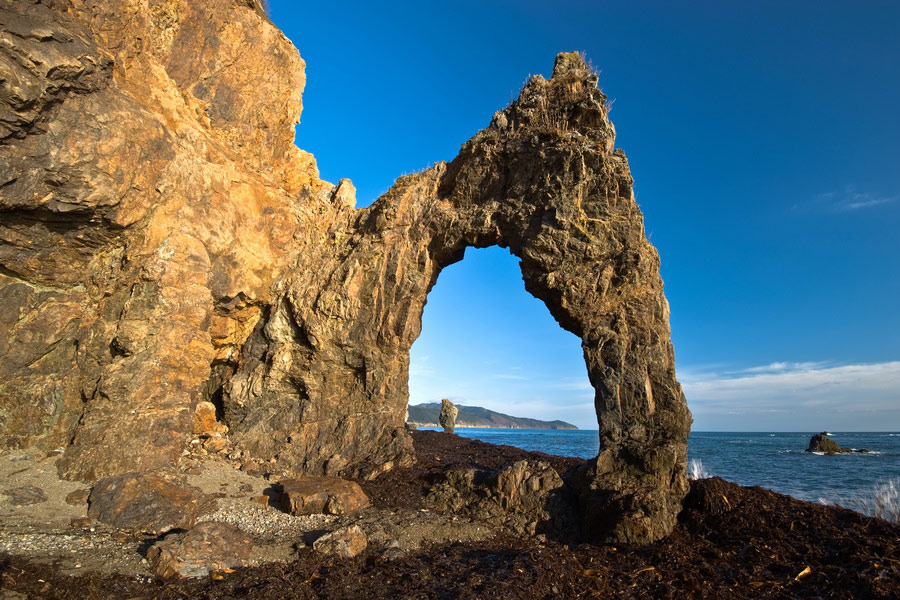
Tours, Attractions and Things To Do in Sakhalin
Sakhalin is the largest island of the Russian Federation. It is located in the Pacific Ocean and is famous for seafood and picturesque places. And in the Sakhalin region there is the cutest island in the world - Tuleniy, a favorite place of seals and fur seals.
History of Sakhalin
Scientists confirm that the island was completely inhabited already 2.5 thousand years ago. People led a settled lifestyle and fished.
The first mention of Sakhalin dates back to 1640. At the same time, Russian Cossacks came here for the first time.
In 1855, the Treaty of Shimoda recognized Sakhalin as a joint possession of Japan and the Russian Empire. But already in 1875 Sakhalin was ceded to Russia, which, in turn, gave part of the Kuril Islands to Japan.
In the XIX century Sakhalin was a place of exile.
The largest city on the island is Yuzhno-Sakhalinsk. It was founded in 1882.
About half a million people live on Sakhalin.
Sakhalin Sights
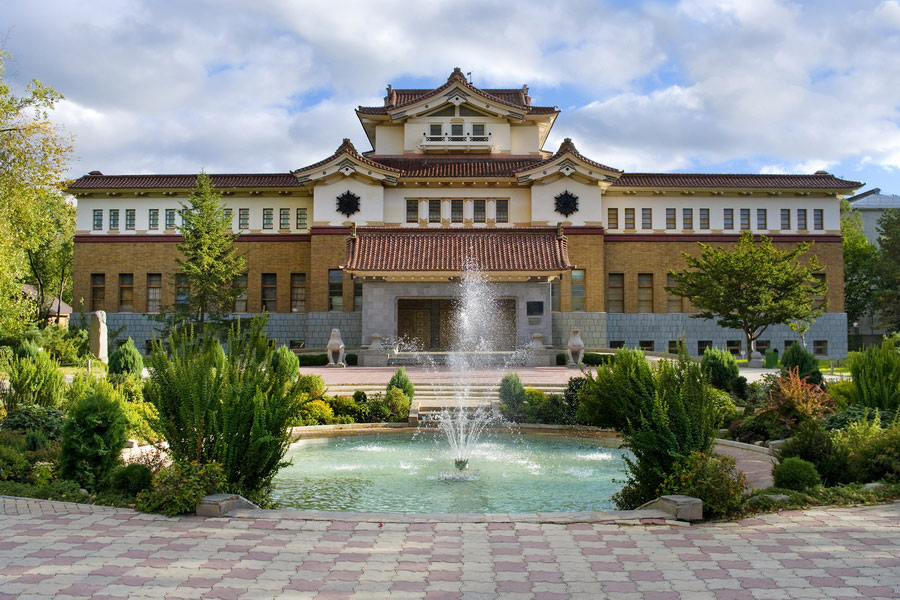
The Sakhalin State Regional Museum of Local Lore is located in a building that was built in 1937 in the teikan-zukuri style designed by a Japanese architect. Here you will get acquainted with the times when Japan owned the island and see how people lived on Sakhalin: what they wore, what they ate, what they produced.
Also in Yuzhno-Sakhalinsk there is a museum of railway equipment, the Sakhalin Regional Art Museum, the Chekhov Museum, the exhibition hall of the Union of Artists of Russia, the Bear Museum, geological and archaeological museums.
The Victory Museum and Memorial Complex is dedicated to the Russian-Japanese and World War II wars. This museum is different from the usual museums of this subject. Here you will learn about the Portsmouth Peace Treaty, about the fighting in the Far East and much more.
The Resurrection Cathedral of Yuzhno-Sakhalinsk is young, it was built in 1995. People come here to bow to the deceased leaders of the Sakhalin Region, headed by Governor Igor Farkhutdinov.
Tikhaya Bay is one of the most famous attractions of Sakhalin. It is so called because it is always quiet and peaceful here. This beautiful place will not leave anyone indifferent. Next to the bay is the Zhdanko ridge, which looks like a dragon.
Cape Giant is considered the most picturesque on Sakhalin. Nature has created columns, arches and peculiar sculptures here - stones that have been polished by water for centuries.
Cape Columnar is also very beautiful. After the eruption of the volcano, basalt pillars appeared here. They look so neat, as if they were created by man.
Take a look at Cape Crillon with its old lighthouse, weather station and border outpost.
The “Mountain Air” resort, located on Bolshevik Mountain, is considered the pride of the island. It is also recognized as the best in the Far East. If you come here in winter, be sure to ski or snowboard, if in summer - look at the city from a height of 600 meters.
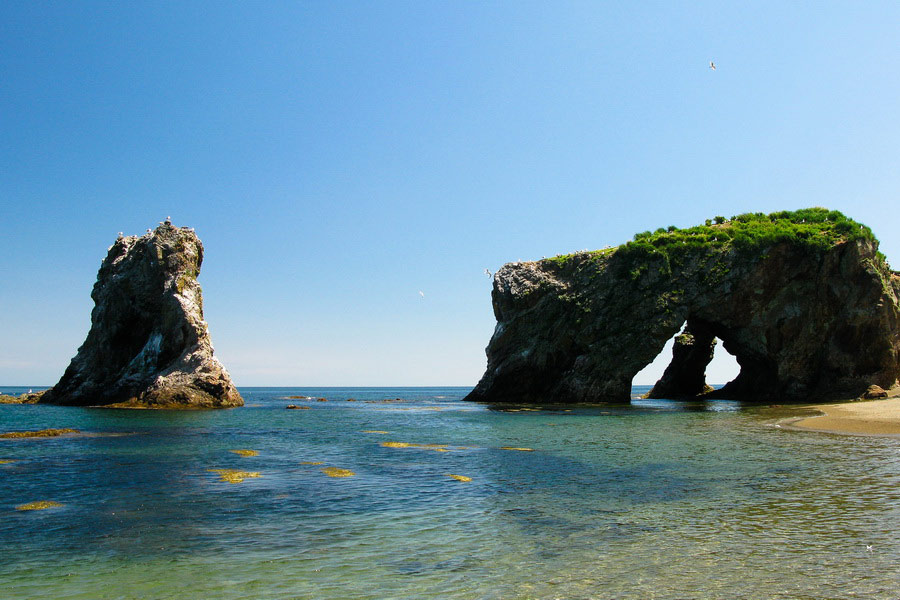
The Poronai State Nature Reserve is home to animals and birds listed in the Red Book. Red Book animals also live in the Noglika Nature Reserve.
The “Vostochny” State Nature Reserve, which occupies 66 thousand hectares, is known for the dark coniferous taiga and animals that are listed in the Red Book. Please note that visiting the reserve is possible only after receiving a special pass.
If you love mountains, then climb Chekhov Peak. It's not difficult to reach the top, and the stunning views will more than pay for a two-hour climb. Also go to the mountain called Frog. It is so named because the outlines of one of the mountain ranges resemble a sitting frog. Once this place was considered a temple of wisdom and a place of power. Do not ignore the Ostraya Mountain. Tourists climb to the top to see the wreckage of the IL-114 plane, which crashed in 1976.
The lighthouse on Cape Slepikovsky, built by the Japanese, looks very picturesque. You can climb to a 28-meter height and take beautiful photos.
The 30-meter lighthouse at Cape Aniva was also built by the Japanese in the 1930s. In the 1990s, it was converted into a nuclear one, and now it is abandoned. You can get to the lighthouse only by sea.
The rocks of the Three Brothers will surprise you with their panorama. It is said that once three brothers stole the sorcerer's treasures, and for this he turned them into stones. By the way, Chekhov wrote about these rocks.
The beaches in Okhotsk, Yablochny and Starodubsky will appeal to lovers of lazy recreation. For example, the beach near the village of Yablochnoye is considered one of the best on Sakhalin. There is fine sand and a warm sea. And on the beach of the village of Starodubskoye, you can find reddish Sakhalin amber.
Lake Busse is worth a visit, if only to collect oysters that appear on the shore at low tide. We also advise you to go to the lakes Gorachee, Kipyashee, Tunaycha and Vavay lakes, Bird waterfalls, Cheremshansky, Ilya Muromets and Klokovsky.
The port of Korsakov is one of the largest ports in the Far East. People come here to admire the panorama and see the big ships, because the port has the status of an international one.
The seaside thoriums of the Higashi Shirauda Jinzda Temple - the gate left over from the Shinto temple – is one of the most photographed points of Sakhalin. There are also remains of the Temple of the Sun on the island.
Pugachevsky mud volcano is not a classic volcano. It is a perfectly round clay desert with a diameter of 4 kilometers. There is a swamp around the perimeter. Every few years, the volcano spews thousands of tons of mud, and the fountain can reach 50 meters in height. Another mud volcano is located near the Novoderevenskoye station. There are several constantly bubbling craters here.
If active recreation is not enough, you can go to the caves of Mount Vida. Pay attention to the cave of Bear tragedies, it is considered the most interesting.
Moneron Island is very small, but very beautiful. There are amazing views here. You can only get here with an excursion group.
The Tuleniy island is one of the cutest islands of the Sakhalin region. Seals and sea lions (big-eared seals) like to lie on a small island with a length of 636 meters.
Dagin thermal springs are almost 60 hot springs that gush out of the ground at a rate of three liters per second. The springs are considered healing and attract the attention of not only tourists, but also local residents.
Sinegorsky mineral springs are located near Yuzhno-Sakhalinsk. They are famous for the fact that the water contains arsenic. This mineral water cures many diseases. Therefore, two health resorts were built on the springs, where people come not only from Russia.
Be sure to visit the Kuril Islands. The state Nature Reserve "Small Kuriles" includes the islands of Zeleny, Storozhevoy, Shikotan, Rifovy, Anuchin, Signalny, Polonsky and Tanfilyev. Here are the famous Tyatya volcano, the Kuril Reserve and much more.
What to bring from a trip to Sakhalin?
Take a bigger suitcase with you because you will not leave without gifts and souvenirs. Be sure to bring seafood from the trip: fish, caviar, Sakhalin crabs, seafood. Grab the national unts as well. Girls will love the jewelry of indigenous peoples. Music lovers will be pleased with the musical instrument harp. Also take syrup from a local berry called klopovka, chocolate with squid and algae and traditional amulets.

IMAGES
VIDEO
COMMENTS
A visit to the Artists Village is among the top choices of things to do in Hua Hin and Attractions. The look and feel of the place and the restaurant next to the lily pond alone may make it well worth a visit, as it did for me. Address: 299/8 3218 Tambon Hin Lek Fai, Amphoe Hua Hin, Chang Wat Prachuap Khiri Khan 77110.
About Hua Hin Artist Vilage Baan Sillapin Artists Village is Hua Hin's original arts centre and includes large galleries of arts and antiques, artist studios, a coffee and gift shop, and classrooms for their very-popular classes in painting and sculpture. It is well known as Baan Sillapin and is a frequent host of special exhibitions and performance events.
Artist Village is a 1.6-hectare location along the hill west of Hua Hin that was intended reserved for local artists to share art space. This location gradually became a popular tourist attraction. Visitors to Hua Hin may locate and purchase unique paintings as well as make their own works of art. This is also where many artists live and work after their exhibits in Bangkok.
Raghurajpur Artist Village is a heritage village about 20 minutes drive from Pipli. The village is renowned for its unique Pattachitra art, a traditional style of painting that involves intricate detailing, vibrant colors, and mythological narratives. The Pattachitra art form primarily depicts stories from Hindu epics like the Ramayana ...
Baan Kang Wat - Chiang Mai's Artist Village Northern Thailand is famous for its rich artisan culture, from woodcarving and umbrella making to handmade food items. Visit Baan Kang Wat Artist Village near Aleenta for handmade products as well as workshops and classes!
Raghurajpur Artist Village is a heritage village about 20 minutes drive from Pipli. The village is renowned for its unique Pattachitra art, a traditional style of painting that involves intricate detailing, vibrant colors, and mythological narratives. The Pattachitra art form primarily depicts stories from Hindu epics like the Ramayana ...
Ubud Art Village Tour Ubud art village tour is a popular activity for visitors to Bali, Indonesia, Ubud art village tour is full day tour 8 hours for those who are interested in exploring the region's rich artistic and cultural heritage. The tour typically includes visits to several traditional art villages in and around Ubud, where visitors can observe local artisans at work and purchase ...
Discover a must place to visit in Baguio, the Ililikha Artist Village, where culture thrives and creativity blossoms. Unveil the essence of culture of Baguio.
The Best Time to Visit Artists Village in Saputara, Gujarat Monsoon Season (July to September): One of the most enchanting times to visit Artists Village in Saputara is during the monsoon season. The entire region bursts into a palette of vivid greens, offering a refreshing and picturesque backdrop for artists and art enthusiasts alike. This season promises a cool climate, with misty hills and ...
A Traveller's Guide to Baan Kang Wat. Baan Kang Wat is a charming little artist village, set just outside Chiang Mai's old historical town. It is located at the base of Doi Suthep mountain, not too far from Wat Ram Poeng Temple. The village itself is comprised of approximately 10 buildings, and as you wander through the small lush pathways ...
Raghurajpur Artist Village Tourism. Raghurajpur Artist Village is a heritage crafts village located about 14 kilometers away from the city of Puri, Odisha, India. It is known for its master Pattachitra painters, an art form that dates back to the 5th century BC. The artworks are primarily inspired by Hindu mythology and feature intricate ...
Artist Village in Saputara is also popular amongst arts schools that organize various workshops for teaching their crafts. Students of fine arts often visit the village to pick the shades of the craft and get hands-on knowledge about the state of the arts in India. The village also provides simple accommodation for a very reasonable cost.
Raghurajpur Artist Village, Puri Overview Raghurajpur village is a heritage crafts village near Puri, known for Pattachitra paintings, as well as other art forms like palm leaf paintings, wood and stone carvings, papier mache, masks, coconut crafts, and Gotipua folk dance, the predecessor of classical Odissi dance style.
What To Expect? The Artist Village offers an insight into the creative process and production of the works of art created by local tribes. Visitors can also buy their goods.
Watts Gallery - Artists' Village is a vibrant cultural hub in the Surrey countryside. Founded by artists George Frederic and Mary Seton Watts, visitors will encounter art, old and new, in engaging ways. Nestled in the Surrey Hills, Watts Gallery - Artists' Village is just 40 minutes from London, in the village of Compton near Guildford.
Welcome To Spruce Forest Artisan Village, Grantsville, MD. Since 1984 - Christmas in the Village has a been a gift of art and music to our community. We are happy to continue the tradition for another year and will continue to update when programming becomes available. Friday: 4pm to 8pm, Saturday noon to 8pm. Be sure to use our Shuttle Trolley ...
Kayenta's Art Village is a hub of cultural and social activity for locals and visitors alike. Nestled against the Red Mountain in true red rock country, just seven miles north of St. George, near Ivins, Utah, lies the hamlet of Kayenta, and its famed Kayenta Art Village — it's tranquil but not secluded. Conscientious growth and the use of ...
Little village. Big fun. Located on the south bank of the River Walk, La Villita (which, translates to "little village") occupies one square block in the heart of downtown San Antonio. The village is on the U.S. government's National Register of Historic Places as a Historic District, and its architectural styles range from simple adobe structures to early Victorian and Texas vernacular ...
The Village of the Arts is an eclectic live-work community made up of colorful historic cottages that house everything from award-winning restaurants to specialty shops, studios, healing arts, bakeries and Bradenton's best art galleries. Join us during our popular art-walks the first Friday night and Saturday afternoon of every month, where you'll be greeted with live music, incredible ...
Olde Mistick Village show lets visitors get up close, personal with artworks, artists Daniel Drainville, The Day, New London, Conn. September 1, 2024 at 8:33 PM · 5 min read
An Anglesea venue started by a local general practitioner with a passion for music is bringing international artists to the town's humble town hall. ... To see the full list of nominees and to ...
Top Yuzhno-Sakhalinsk Landmarks: See reviews and photos of sights to see in Yuzhno-Sakhalinsk, Russia on Tripadvisor.
Things to Do in Sakhalin, Russia: See Tripadvisor's 10,288 traveler reviews and photos of Sakhalin tourist attractions. Find what to do today, this weekend, or in September. We have reviews of the best places to see in Sakhalin. Visit top-rated & must-see attractions.
Authorities have spent around $18m (£13.6m) on the pontiff's three-day visit, which begins on 9 September. "We are very sad," Zerita Correia, a local resident, told BBC News. "They even ...
A Journey Through Giant Burdocks, Wild Bears, and the Echoes of Ancient Japanese Temples From the most dreaded place of exile in the Russian Empire to a Japanese industrial base and one of the most attractive and inaccessible places for domestic tourism in Russia. An island that was Russian, then Japanese, and then Russian again… Read More »Sakhalin: Your Essential Guide to Russia's ...
For example, the beach near the village of Yablochnoye is considered one of the best on Sakhalin. There is fine sand and a warm sea. And on the beach of the village of Starodubskoye, you can find reddish Sakhalin amber. Lake Busse is worth a visit, if only to collect oysters that appear on the shore at low tide.